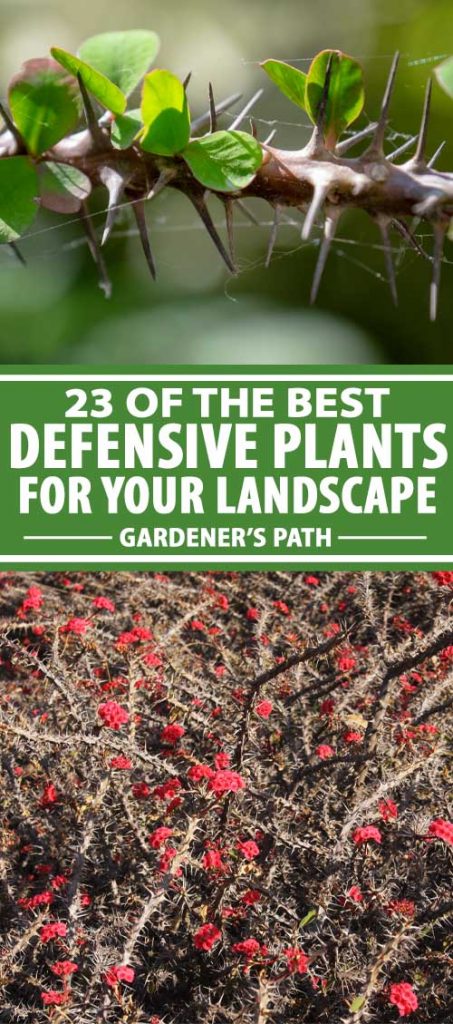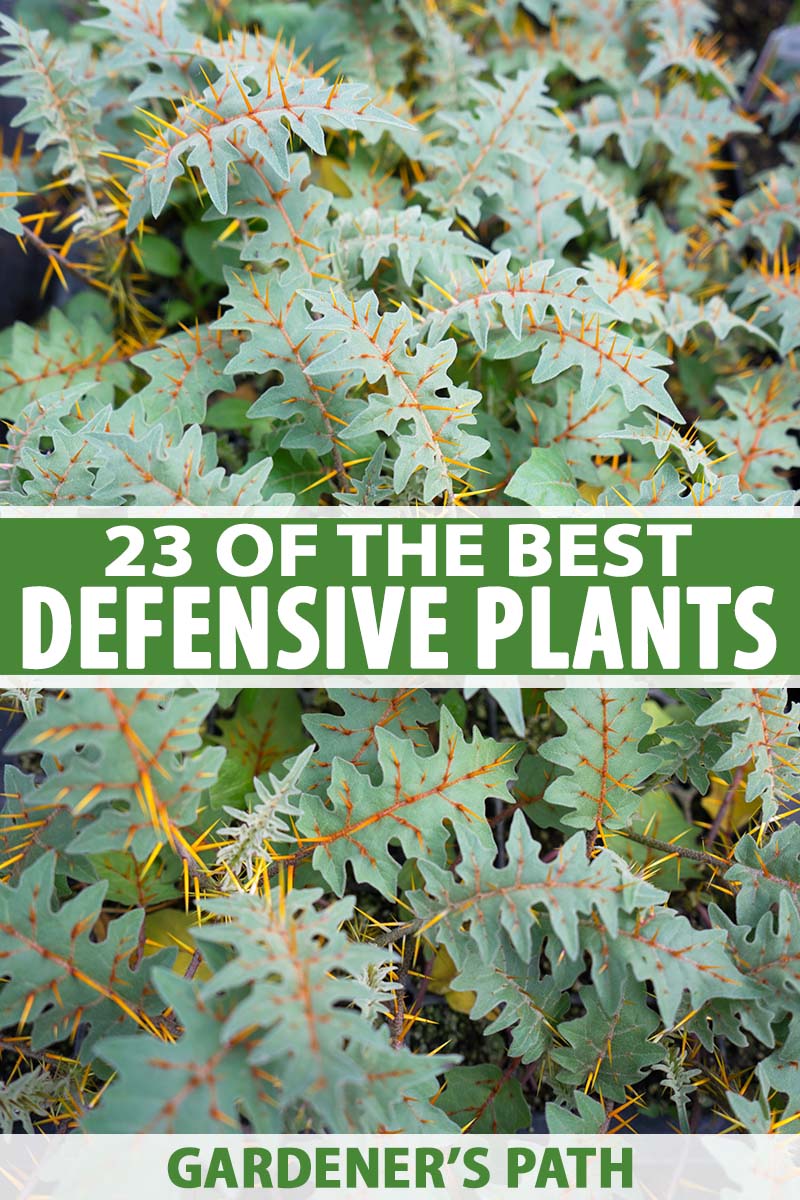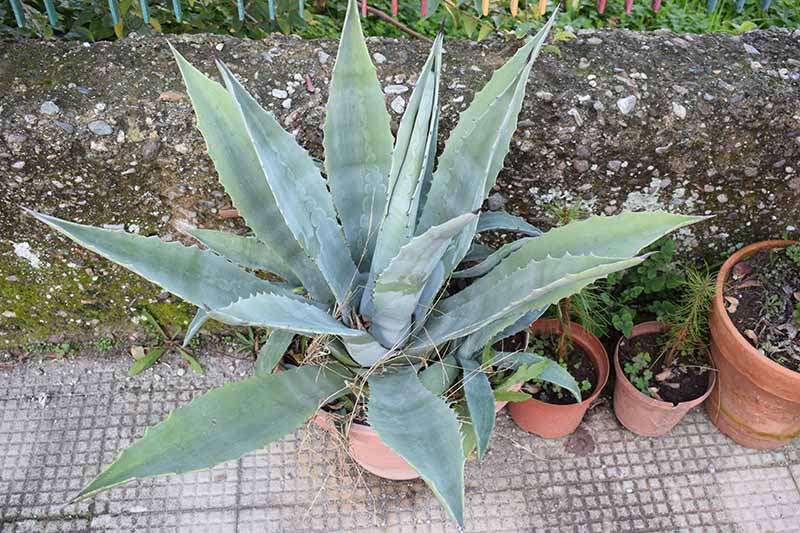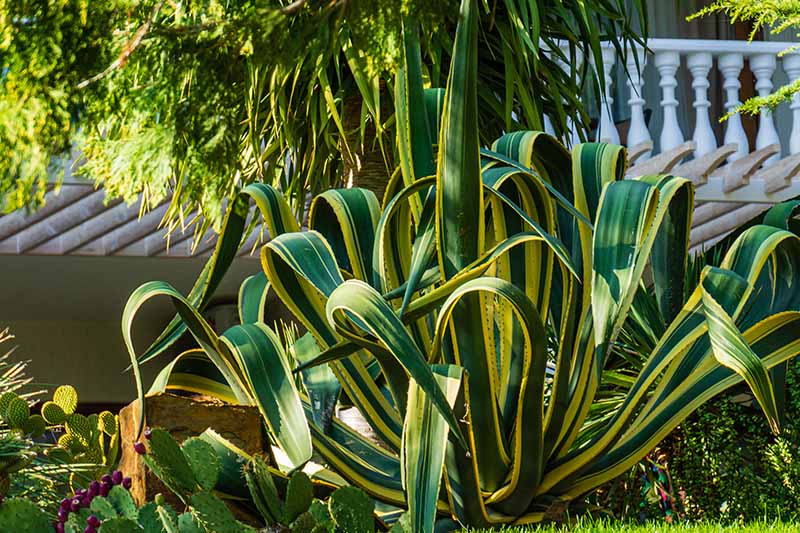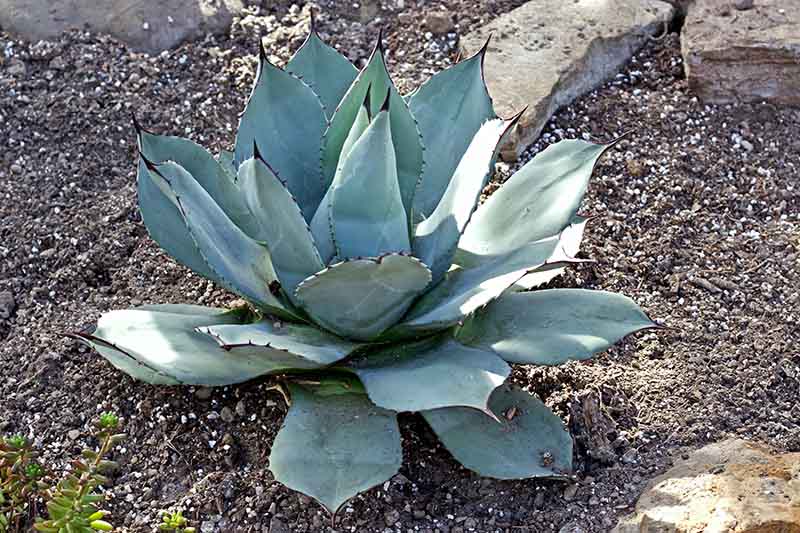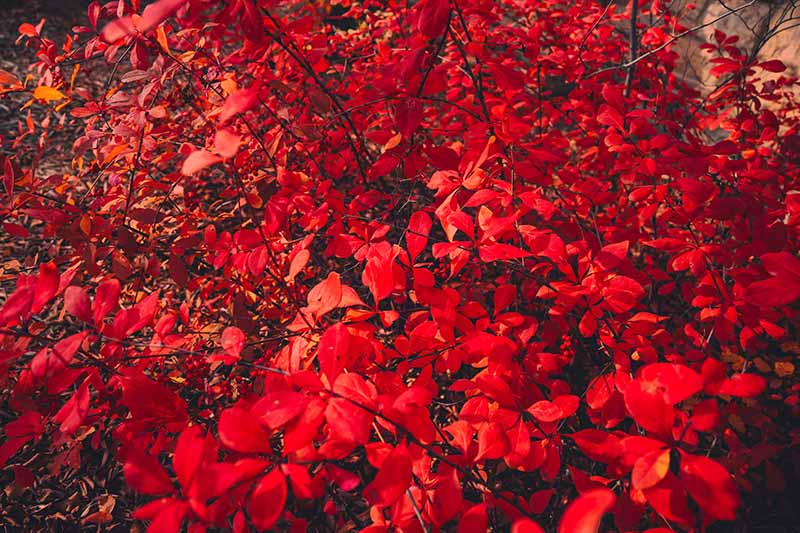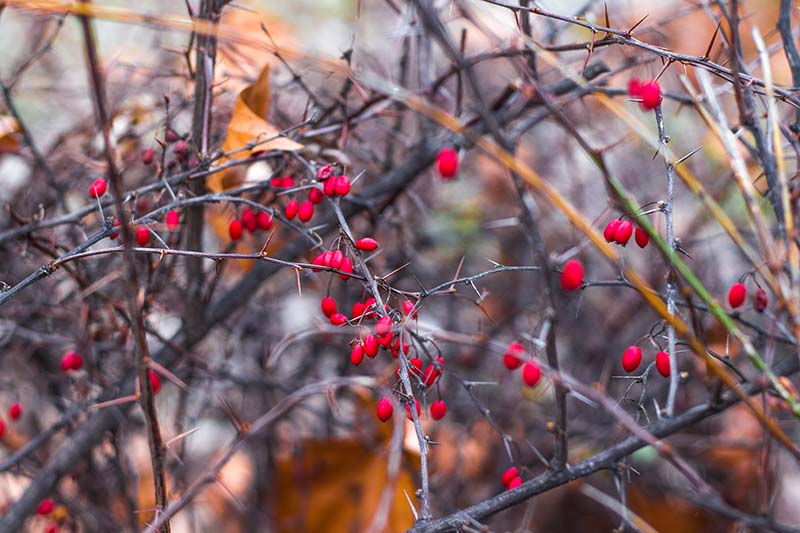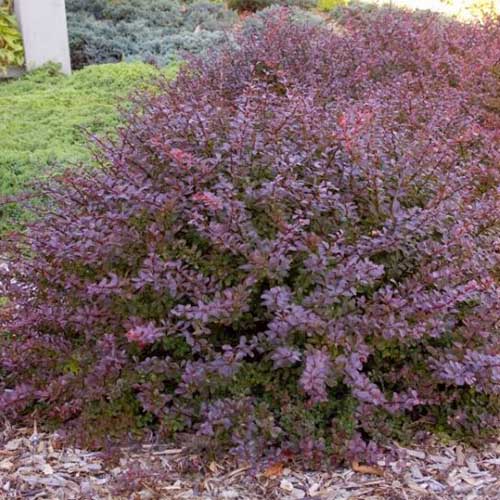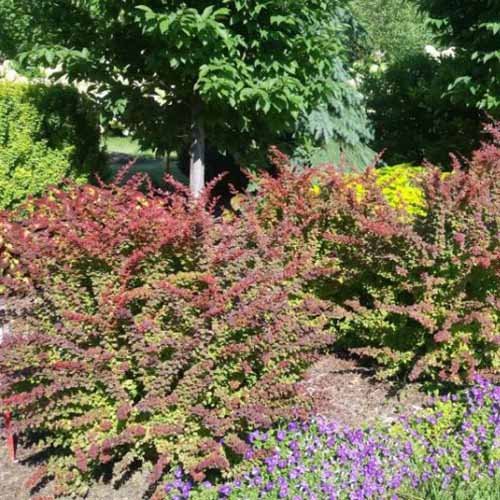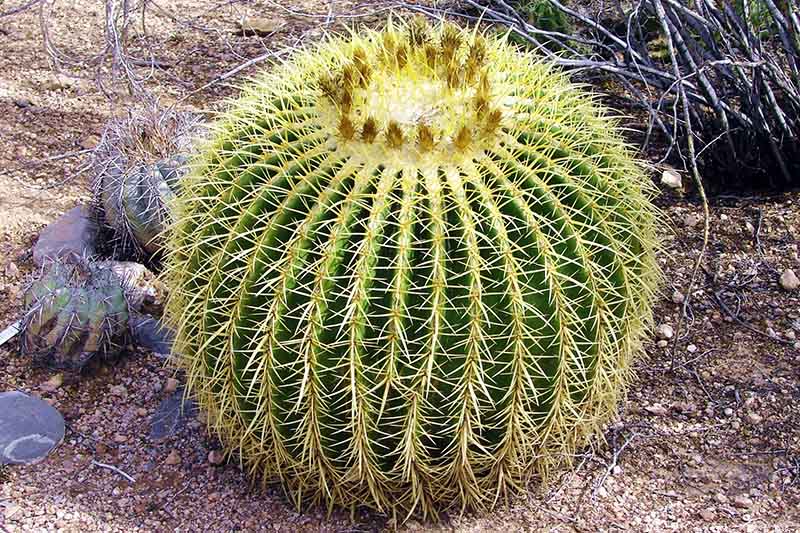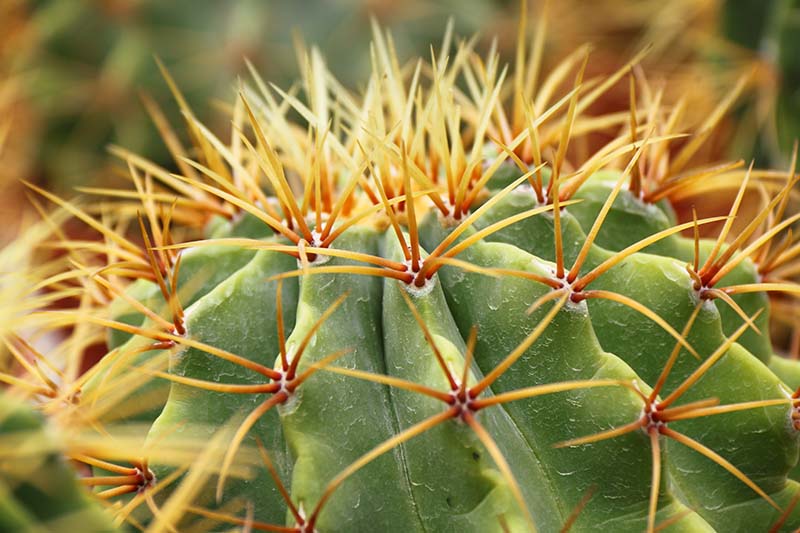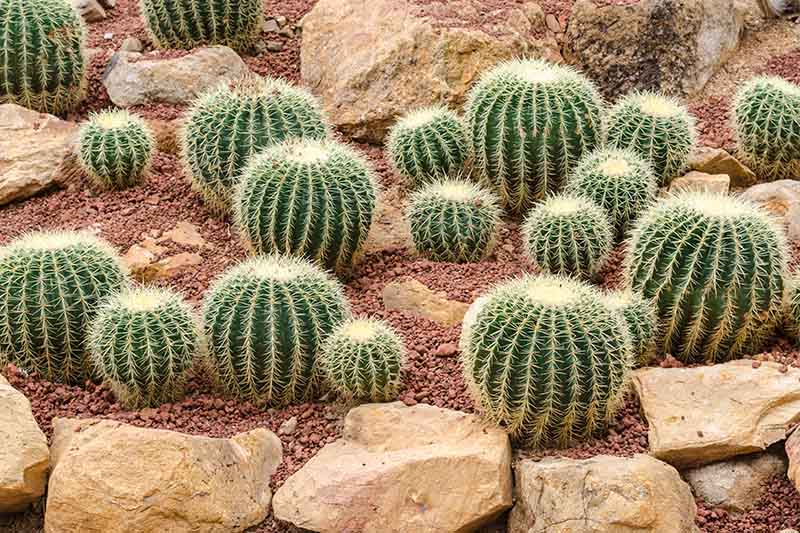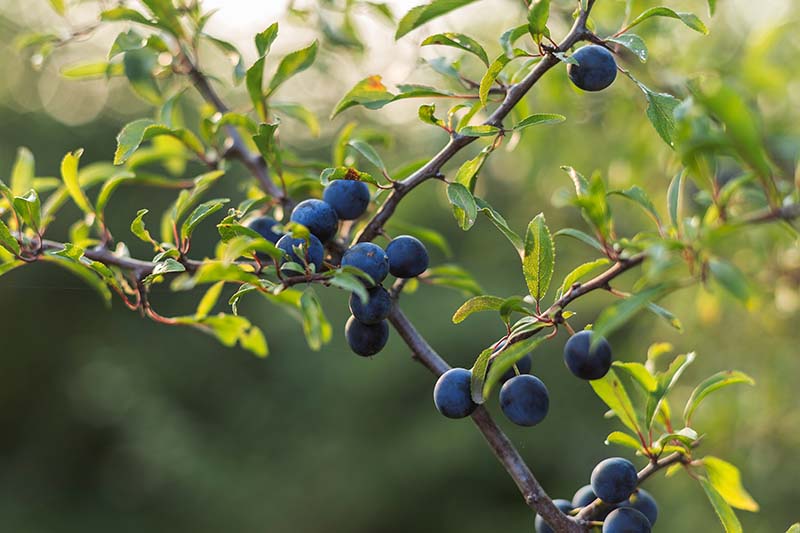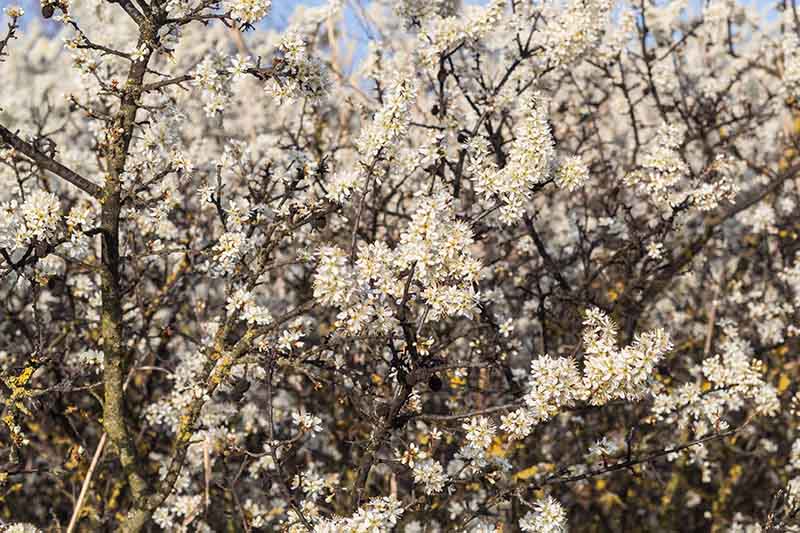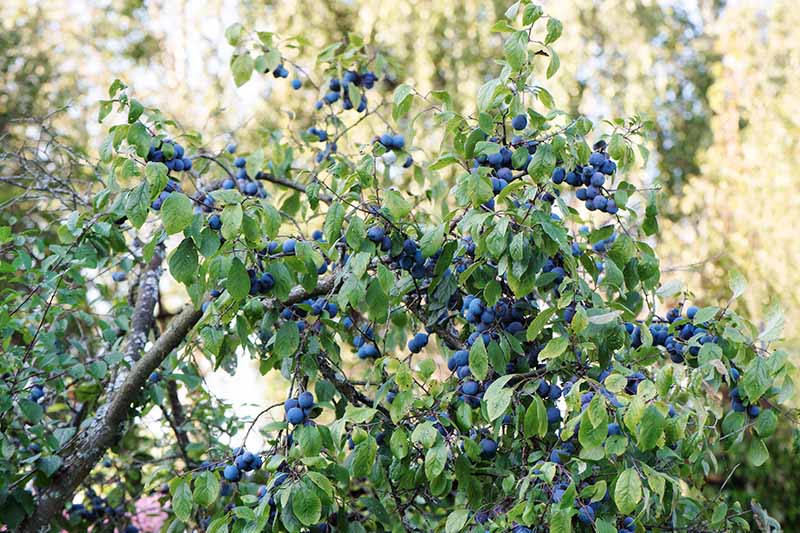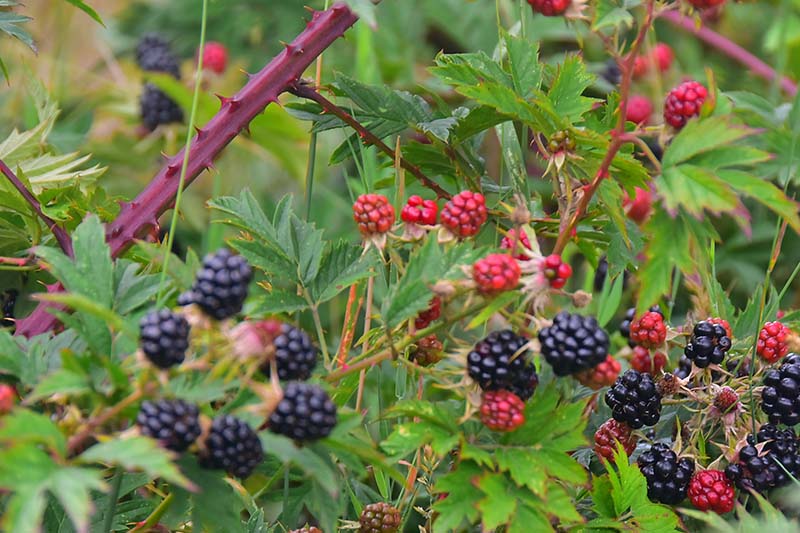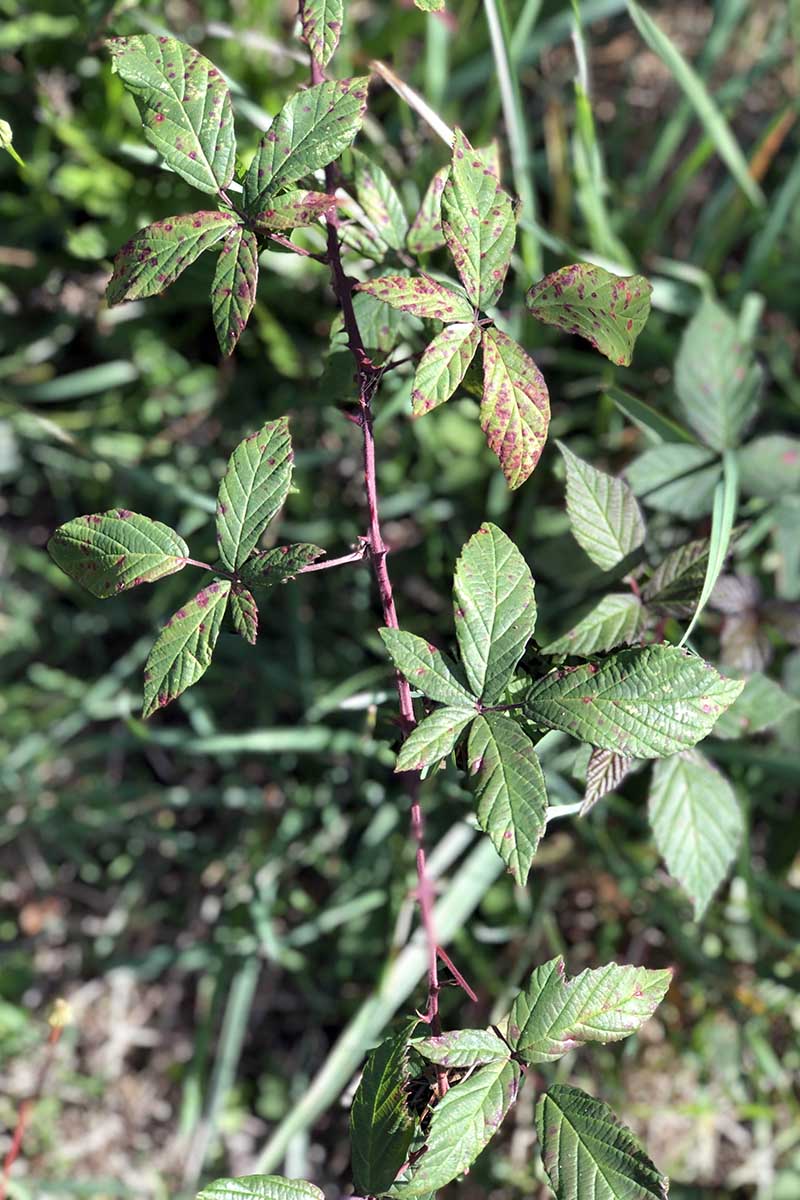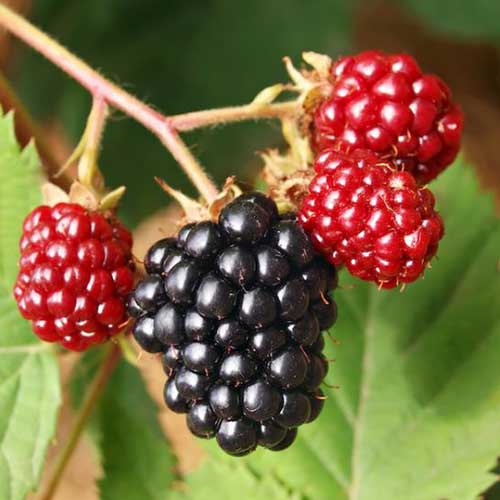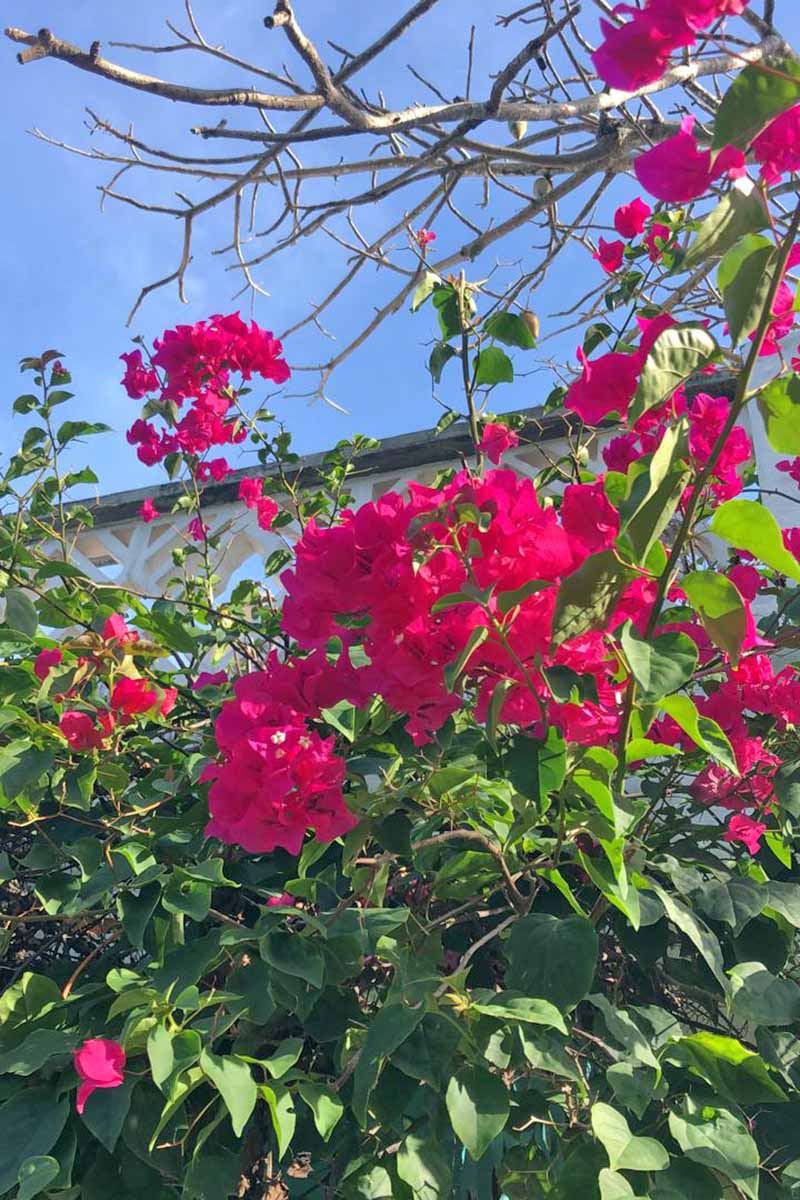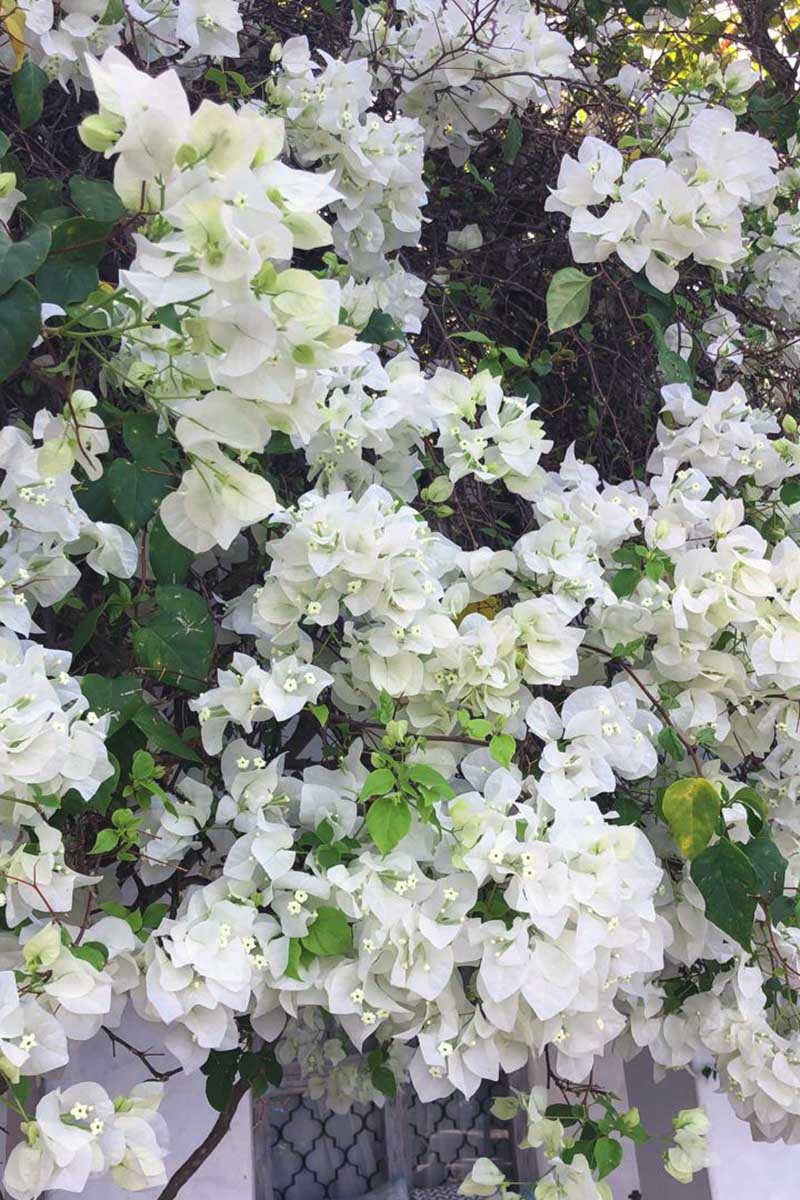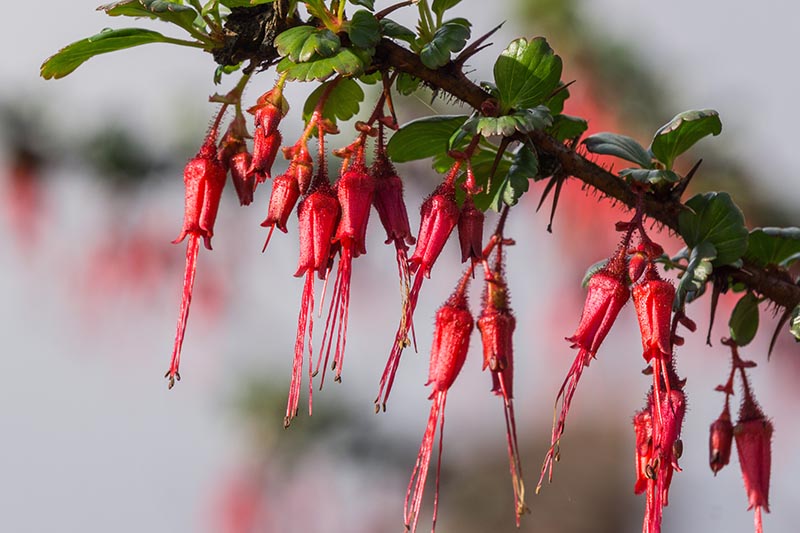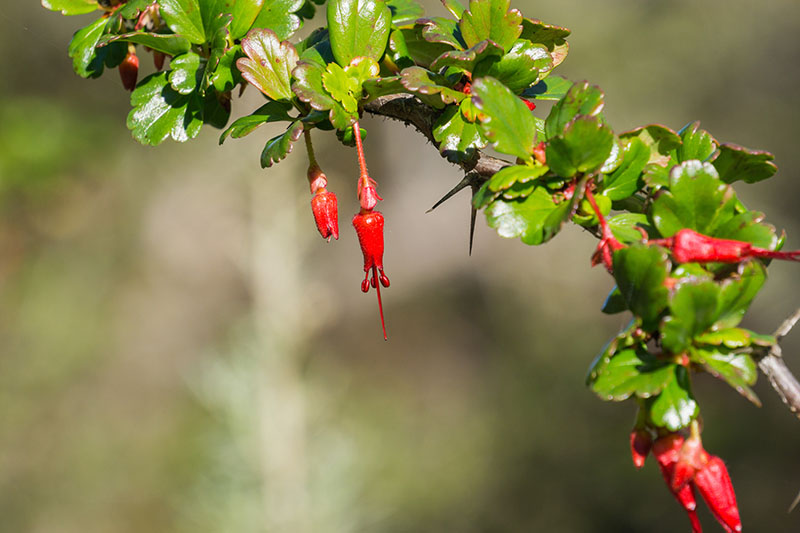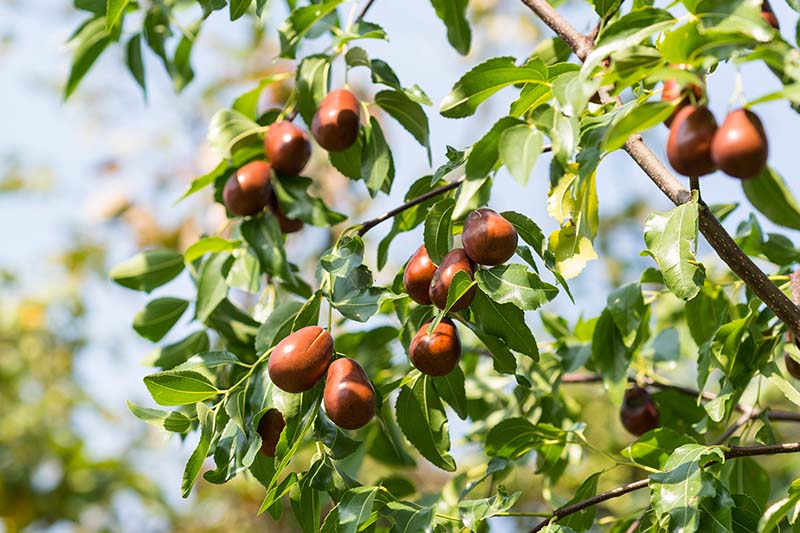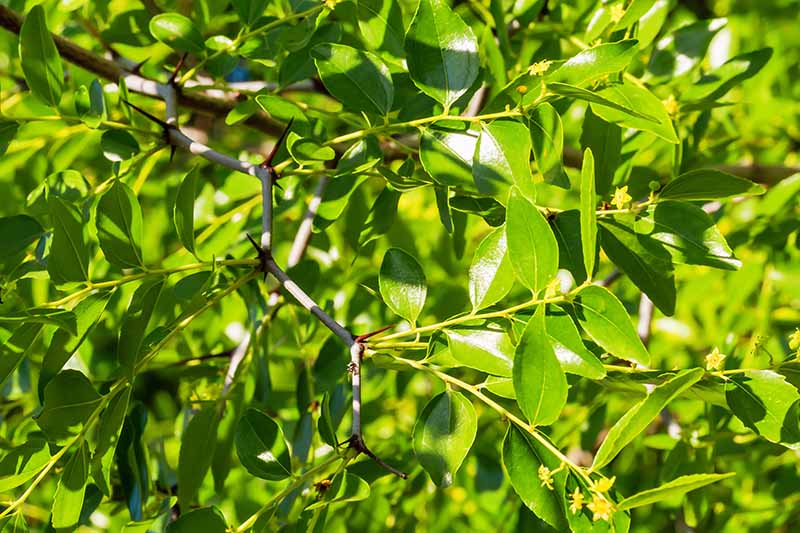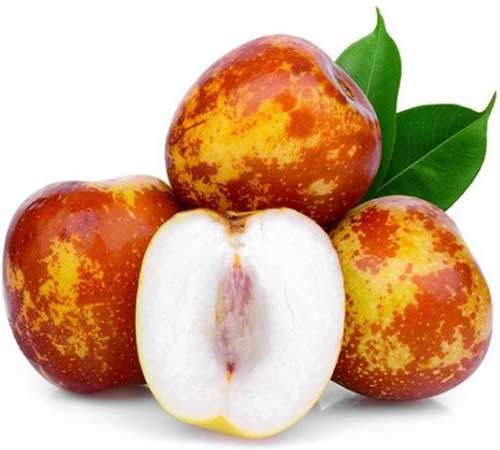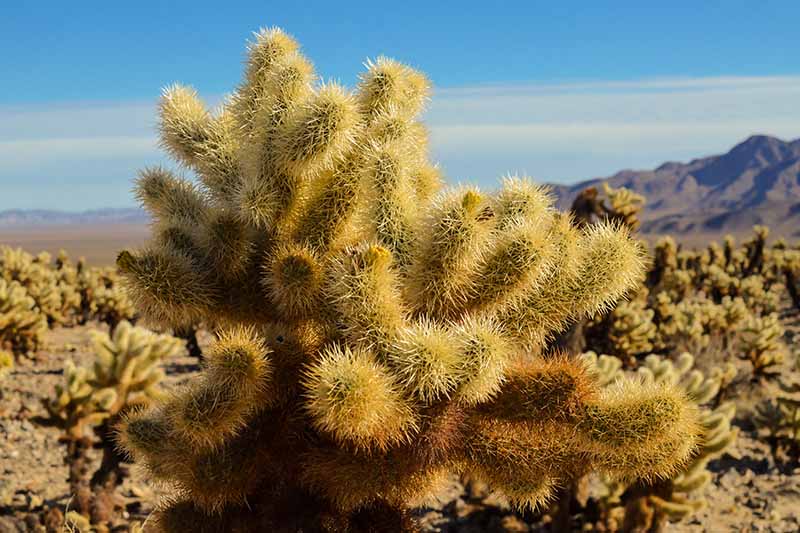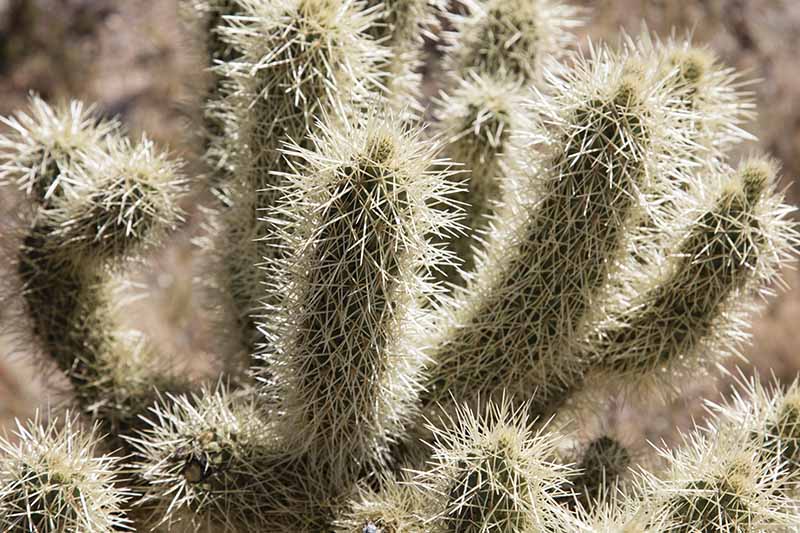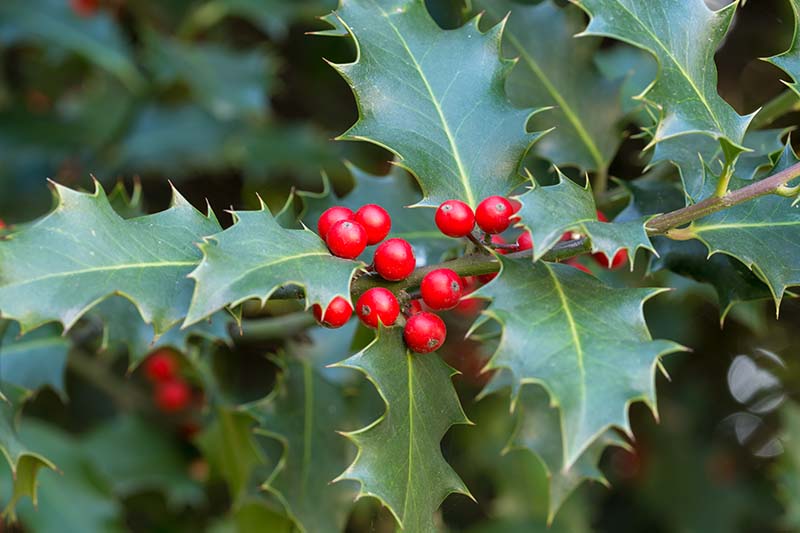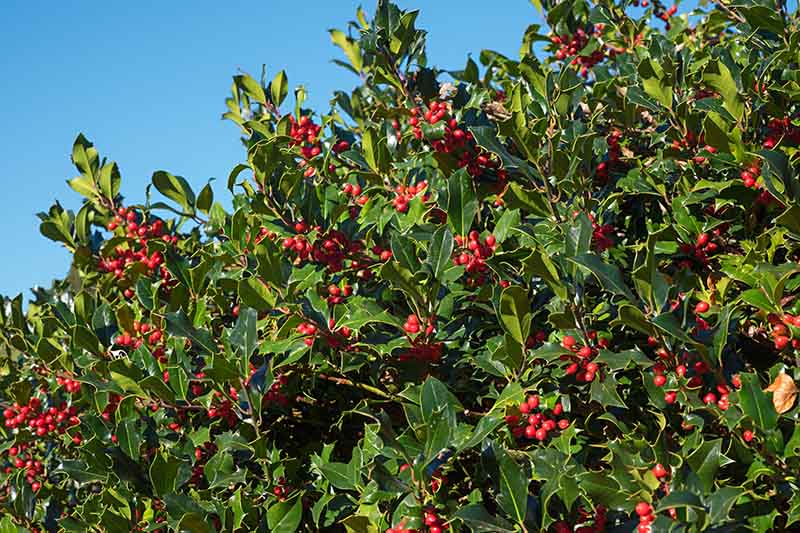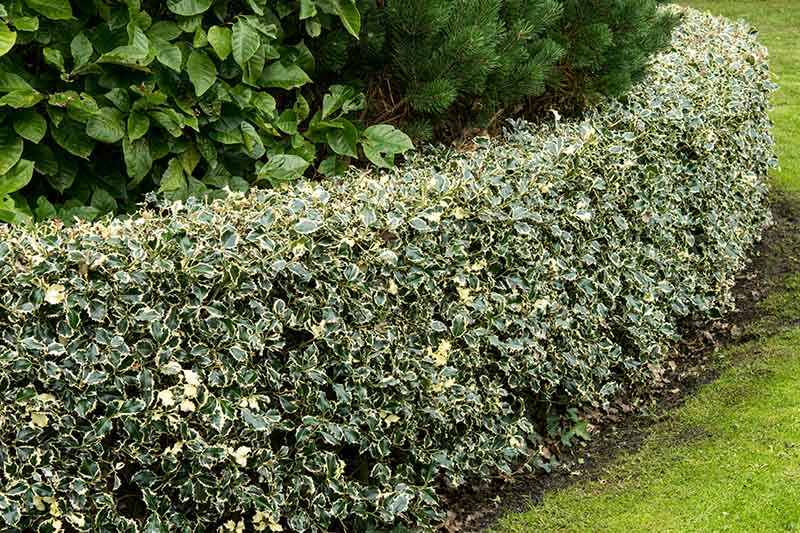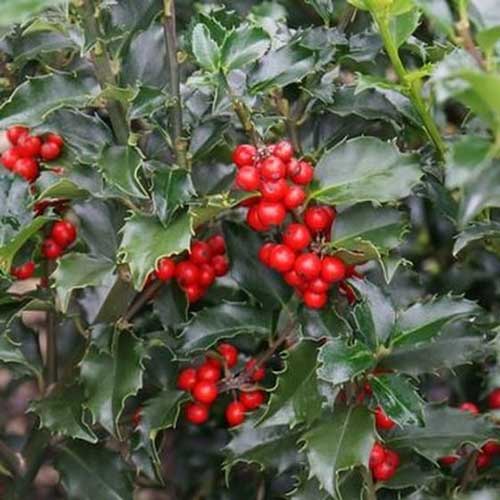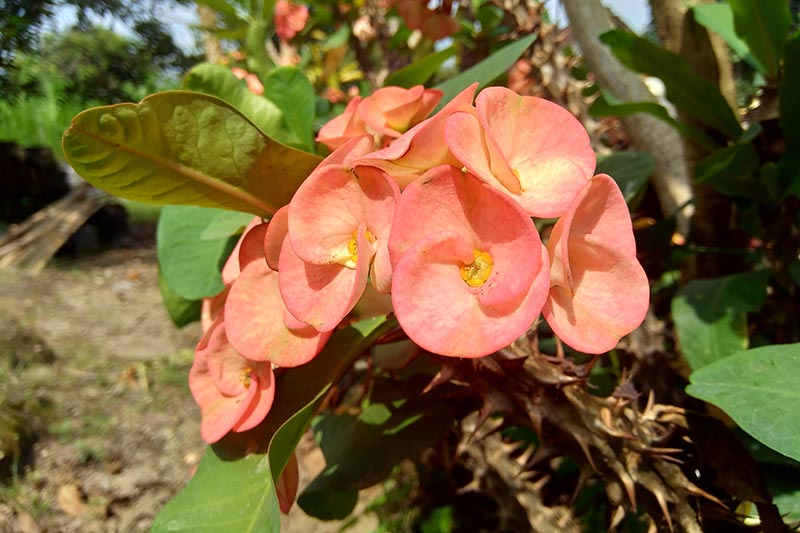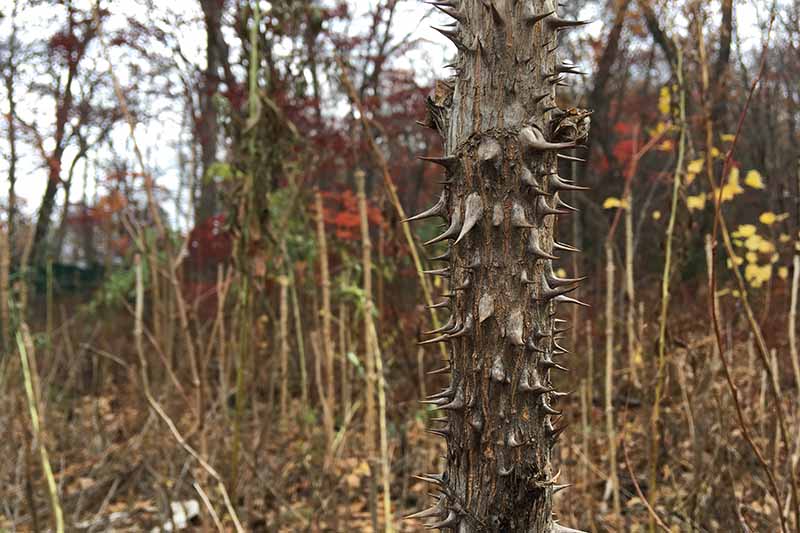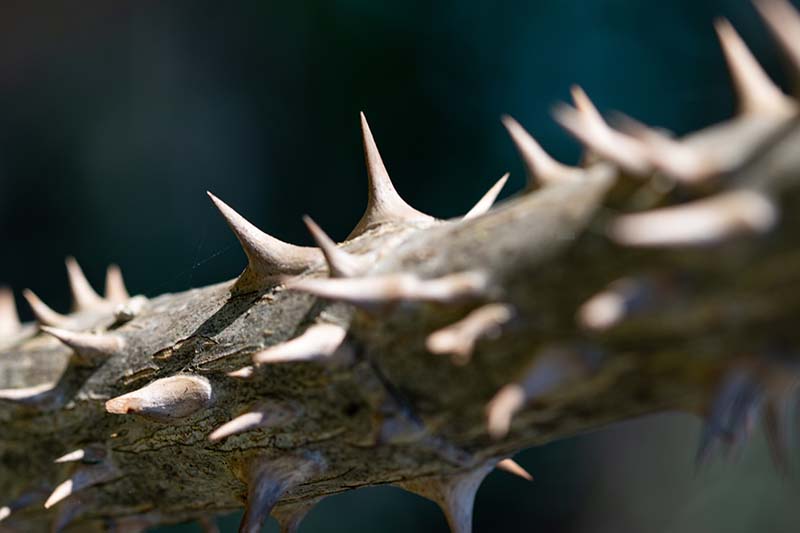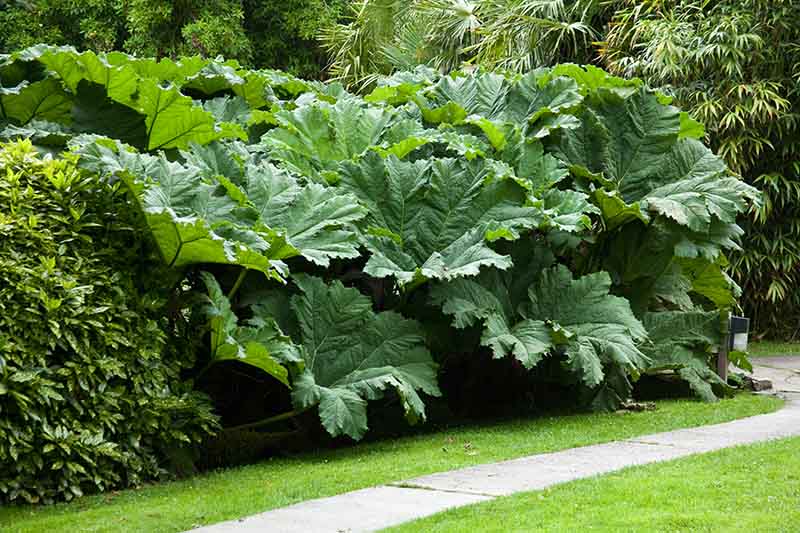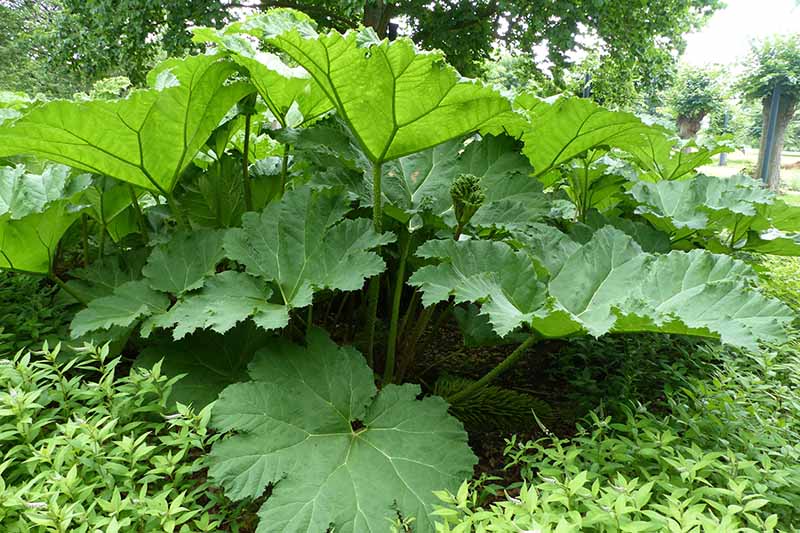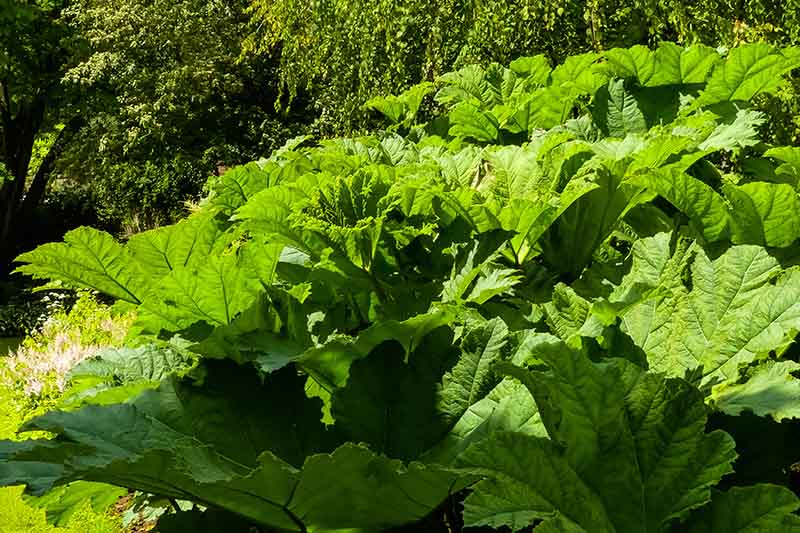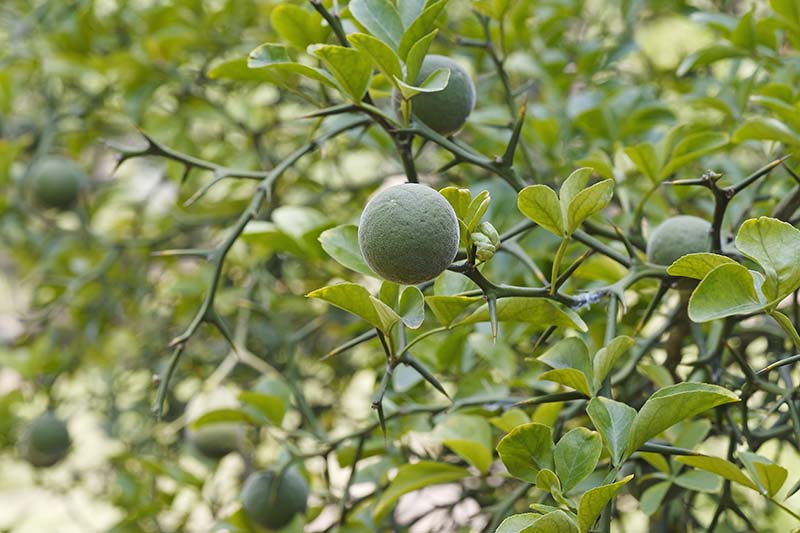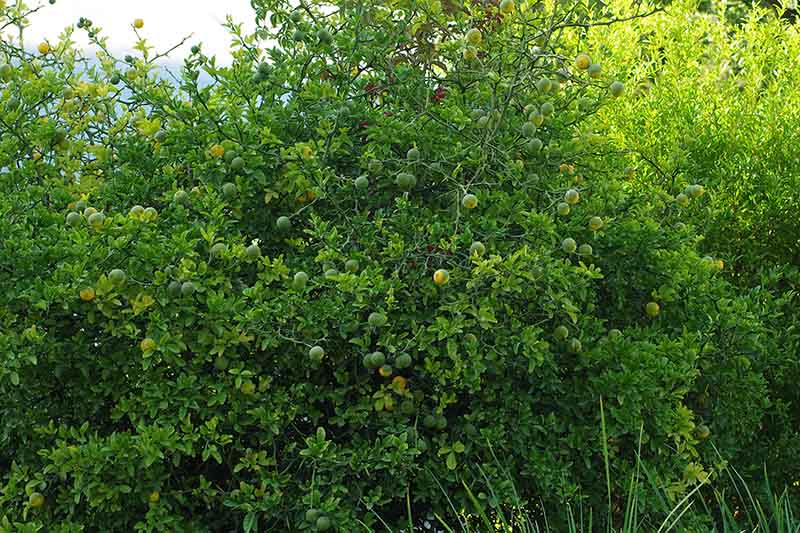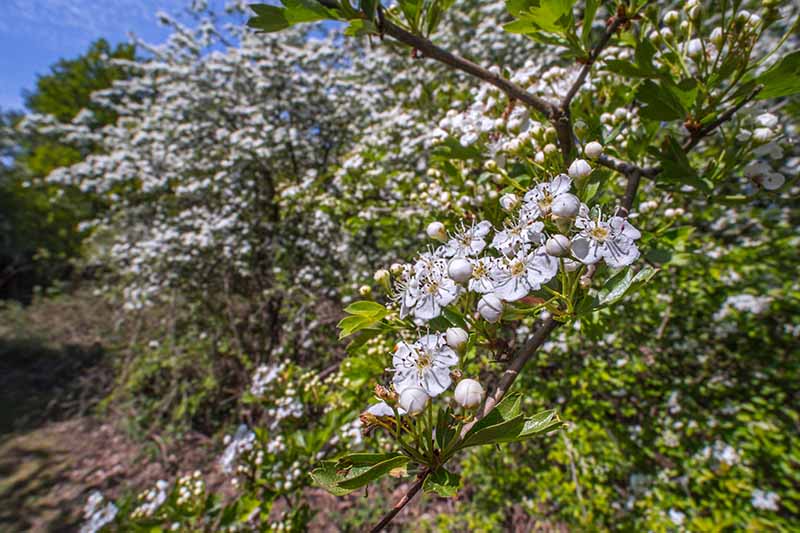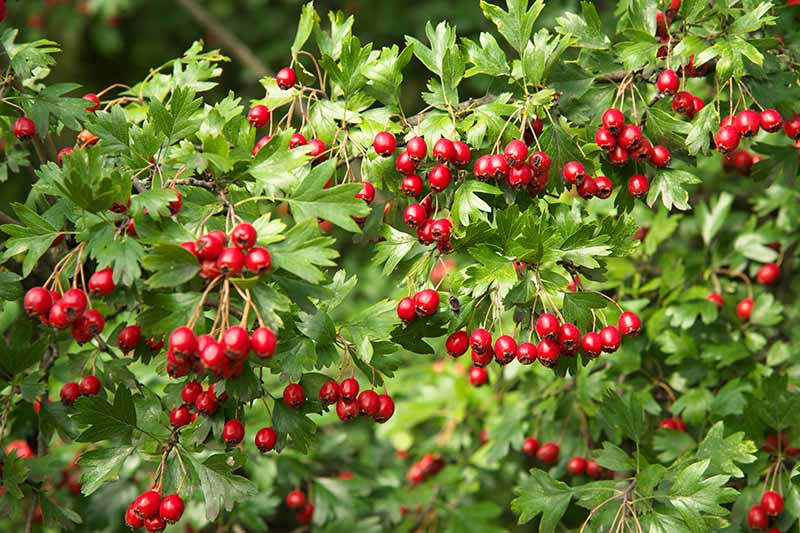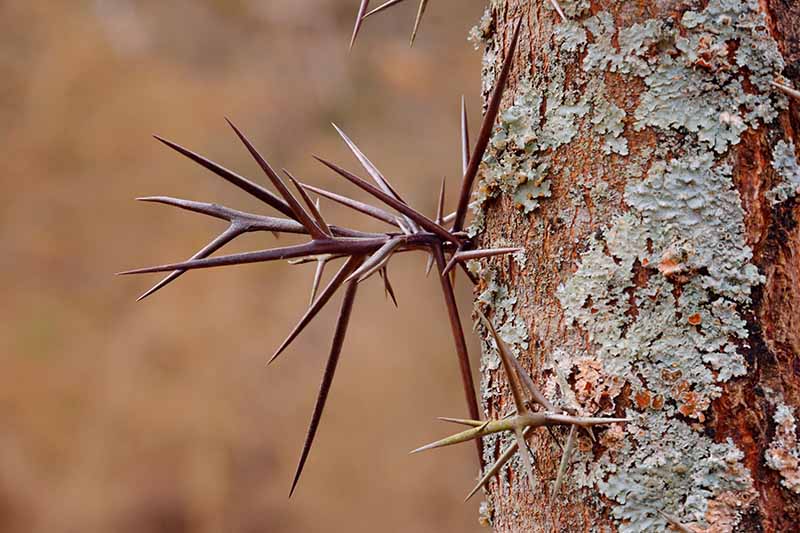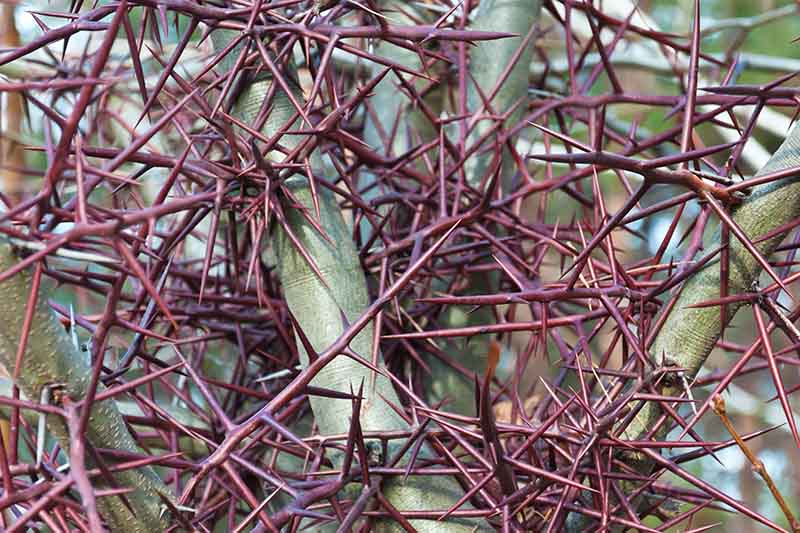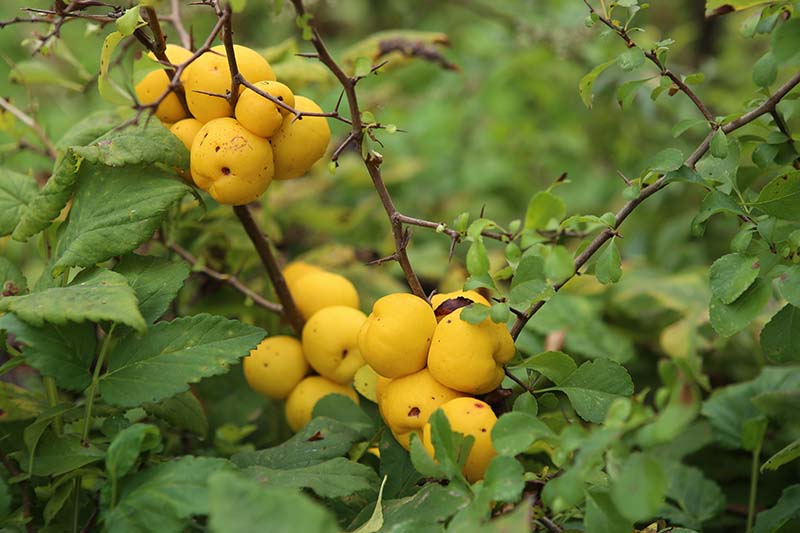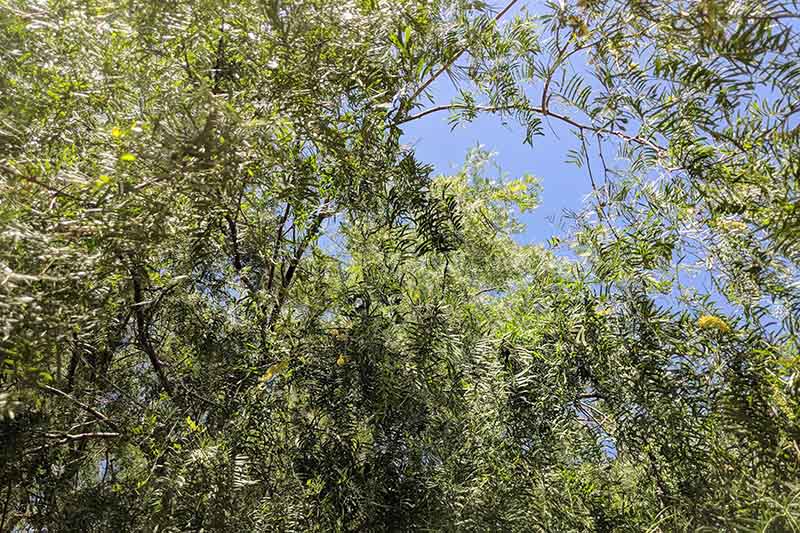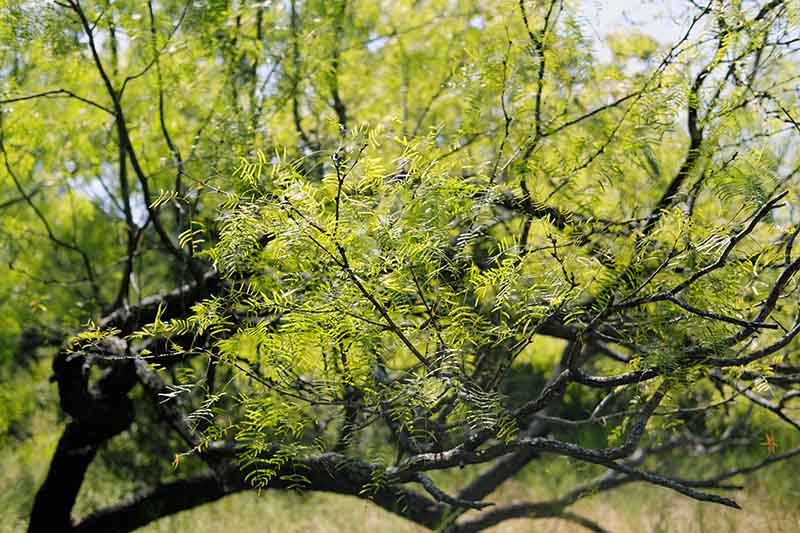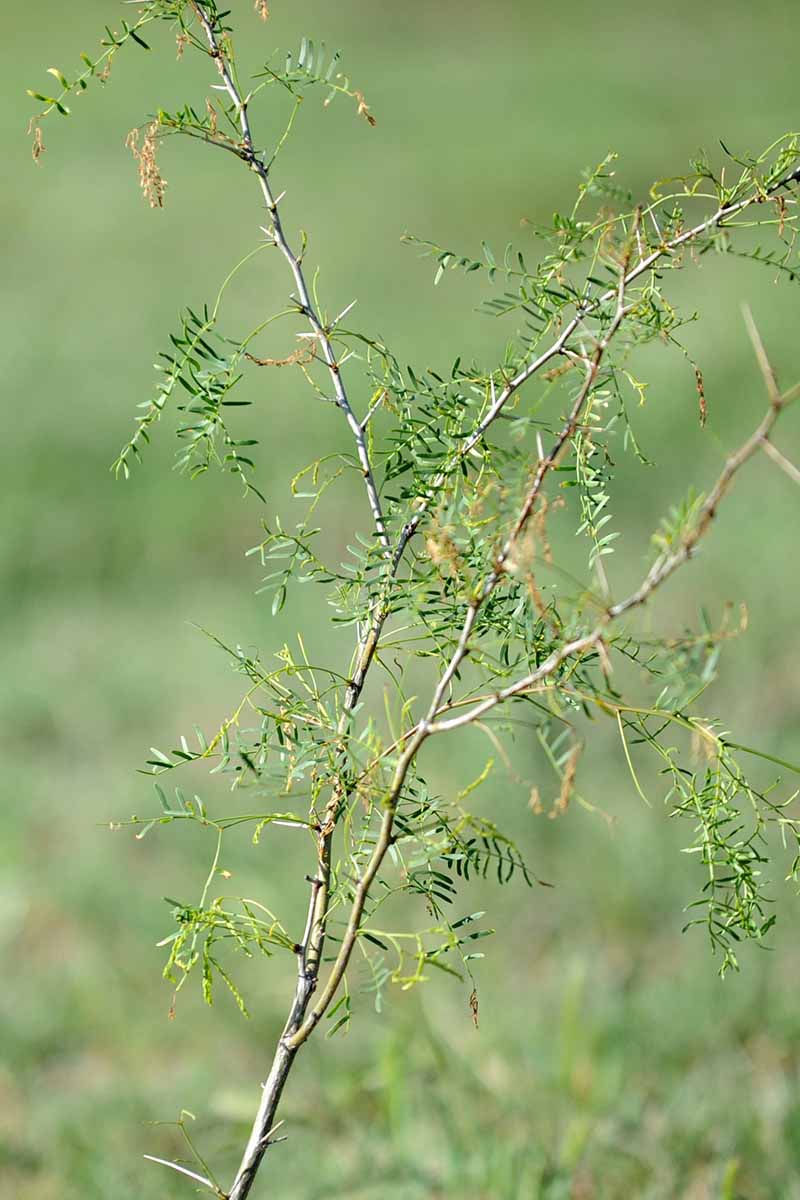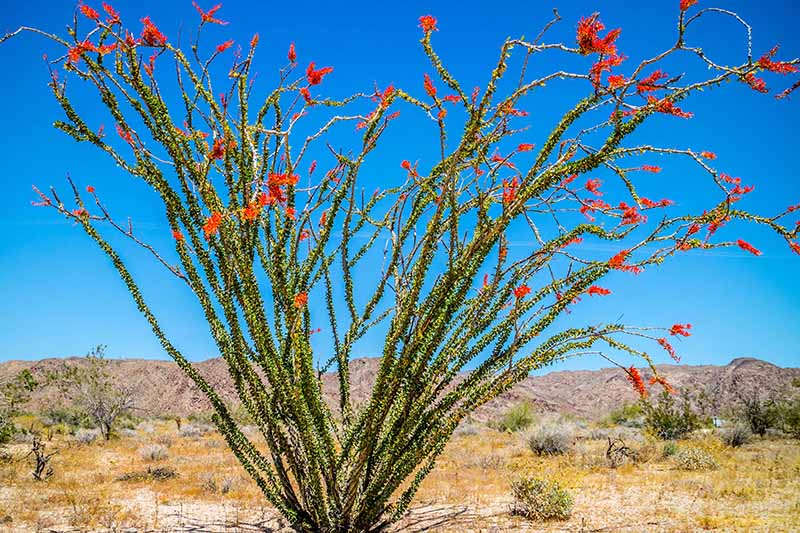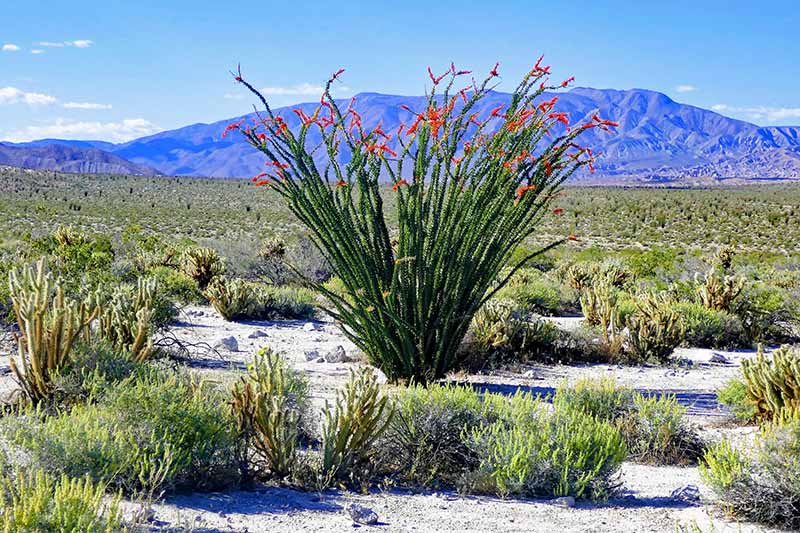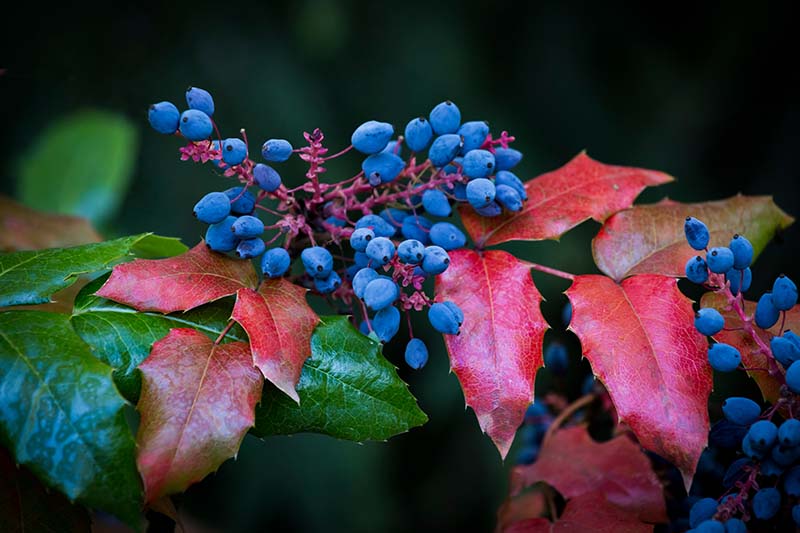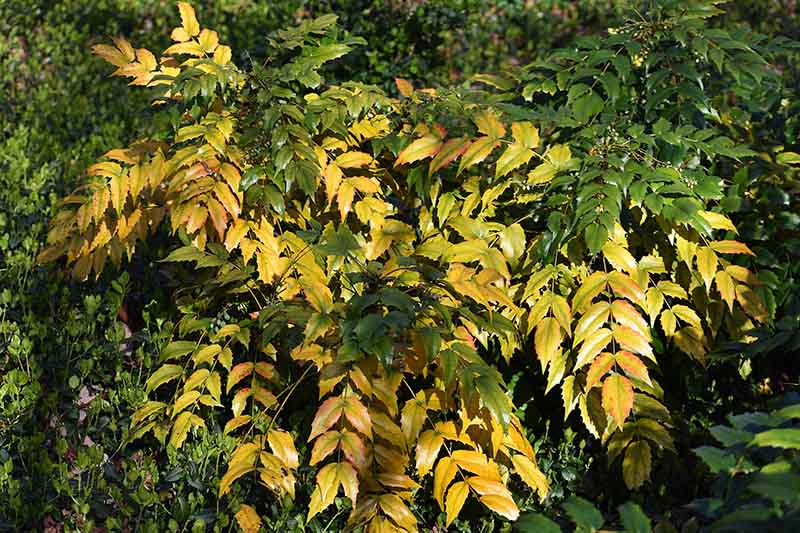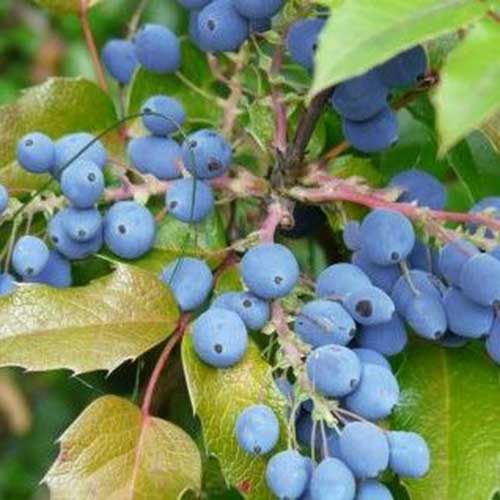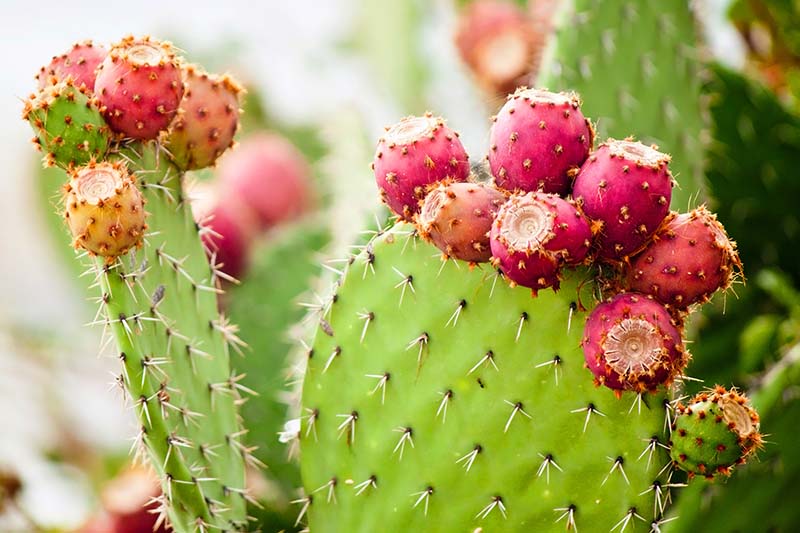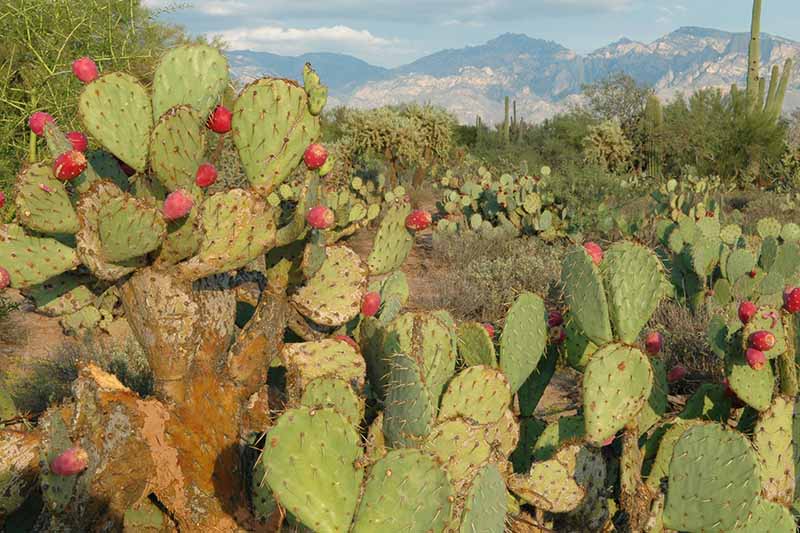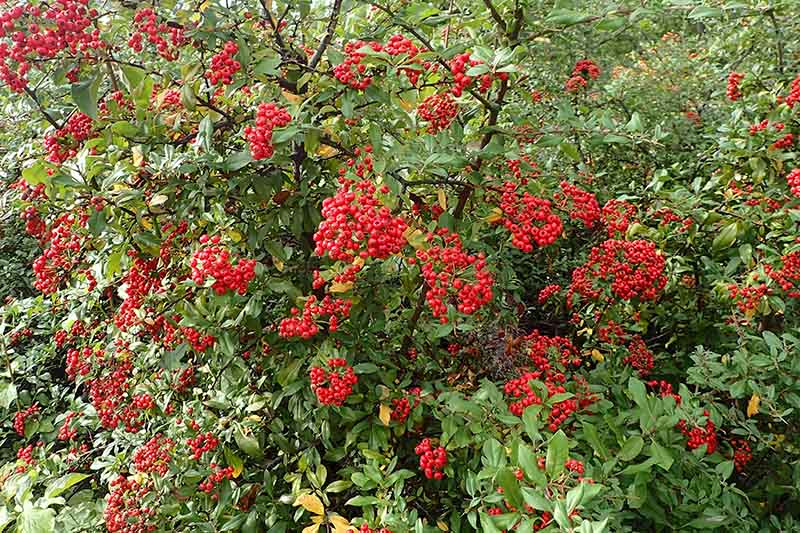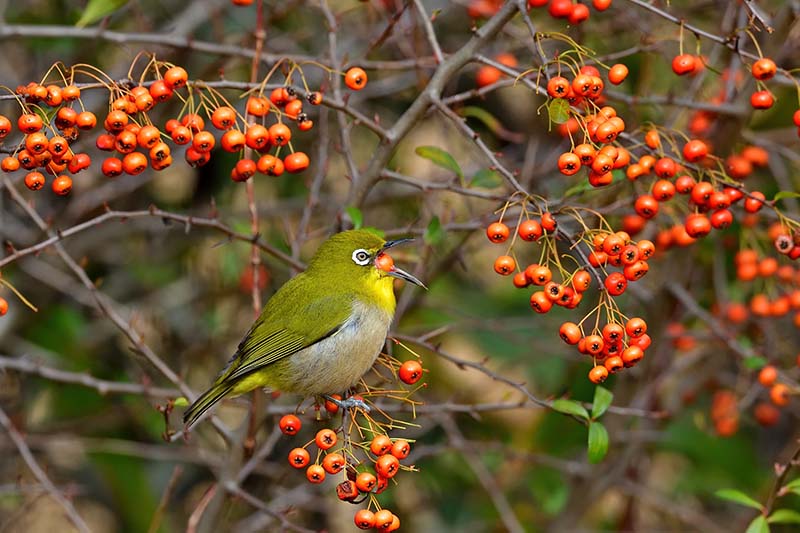By strategically planting thorny, spiky, dense bushes or hedging, you can create an effective barrier to deter intruders without compromising the look of your landscape. Many ornamental shrubs have vicious thorns or spiny foliage, and with careful placement, they can add a layer of security to your home without resorting to barbed wire or expensive fencing. We link to vendors to help you find relevant products. If you buy from one of our links, we may earn a commission. Here’s what I’ll cover:
How to Use Defensive Plants in Your Landscape
There are a variety of ways to use defensive plants as a deterrent and to provide an unpleasant welcome to uninvited guests. When you choose plantings for your landscape, remember to check that they are suitable for your growing zone. Ensure that you keep in mind mature heights, and whether the species you choose is considered invasive in your area. Before you plant, think about your escape routes carefully. In the case of a fire or other disaster, you don’t want your plantings to block your escape or cause injury – this is particularly important in the case of upstairs windows.
Perimeter
The first line of defense for any property is the perimeter. A thorny climbing plant makes it difficult for would-be intruders to scale a fence, and a spiky hedge can make for a decorative natural barrier. Mischief makers will also be put off by the prospect of leaving valuable clues and DNA behind for law-enforcement – like torn clothes or cut skin. Training climbing plants up and along the top of fencing is effective, as is careful placement of shrubs or bushes in vulnerable corners, or on the inside of large fences. Plan your perimeter borders with larger, spiky species at the back, and smaller, equally unwelcoming specimens in front. This can provide a barrier to entry, but still allows you some visibility across your property.
Under Windows
First floor windows are often an easy access point for burglars. Tiptoeing through your pretty flower bed, it’s an easy hop into your home for a quick getaway with your laptop. Consider placing low-growing, spiky plants underneath these windows to make access more difficult – but make sure you check the mature height of the plants or you may end up blocking your view. When you plan your plantings, take care not to obstruct fuse boxes, manholes, or other areas of your house or property that you may need to access for maintenance purposes.
Climbers, Trees, and Window Boxes
Trellising climbing plants up the side of your home, particularly in areas with convenient, climbable drain pipes can discourage the cat-burglar from sneaking into upstairs windows. Remember to prune any trees that may provide access to balconies or windows. Consider an attractive but not-so-welcoming window box full of small cacti on the edge of your balcony to further thwart their efforts.
23 of the Best Defensive Plants for Home Security
Let’s take a look at some of the best plants to secure your property from mischief-makers.
1. Agave
The most common member of the Agave genus is A. americana, otherwise known as the “century plant” or the “sentry plant.” Native to Mexico and the southwestern US, this spiky slow-growing succulent is suitable for growers in USDA Hardiness Zones 8-11. The century plant requires plenty of sun and well-draining soil. It is drought tolerant, ideal for xeriscapes, and is easily propagated from suckers. It grows in an upright fashion with thick, spiny leaves that have a nasty point on the end. Each of these dagger-like leaves can grow three to four feet long, giving the plant a spread of six to eight feet. With a mature height of three to six feet tall, agave creates a formidable barrier. Usually blue-green, there are variegated cultivars available, such as A. americana ‘Marginata,’ which has bright green leaves with yellow edges. You can plant several as a protective barrier, or use individual specimens underneath windows, or on the inside of fences to give intruders a nasty surprise. Just be aware of how large the plant can grow. If you are planting it near your home, consider whether or not you would still be able to use a window as an escape route. There are many species in the Agave genus, some of which are much smaller than the imposing century plant, and others are spineless. The ‘Whale’s Tongue,’ A. ovatifolia, has a lower, more dense profile, with a mature height of three to four feet. Often planted as ornamentals, the attractive foliage conceals a darker side. The branches are covered with leaves that have a single thorn at each node, which makes barberry ideal for creating a dense, spiny hedge, or an impenetrable barrier. Just be sure to exercise caution if you add this plant in your yard. The spines are vicious and can easily take out an eye. Wear proper protective clothing, including safety glasses, at all times when you are cutting it back or gardening nearby. A. americana Century Plant In areas where they thrive, it’s usually possible to find these plants in a variety of sizes at local garden centers and nurseries. Alternatively, you can buy A. americana plants in three-gallon containers from FastGrowingTrees.com. Read our full guide to growing agave here.
2. Barberry
The genus Berberis includes over 400 different species of evergreen and deciduous shrubs with varying heights of three to 10 feet. Shade tolerant, drought resistant, and hardy to Zone 4, barberry grows in almost any type of soil and requires very little maintenance. Some non-native species are considered invasive and growing them is banned in some states, so be sure to check your local bylaws before you plant. Also note that not all varieties have thorns. The Japanese barberry, B. thunbergii, also known as “burning bush” thanks to its brilliant red, striking foliage, was introduced to the US in the 19th century, and has become a popular ornamental shrub. It usually grows in a mounding form and can protect vulnerable corners of your backyard, or provide a spiky welcome when planted underneath windows. There are a number of cultivars that are well-suited to hedging. The three- to four-foot-tall varieties make a very useful barrier along the sides of driveways or walkways, and even as a perimeter hedge, allowing visibility over the top. Another species of interest is the wintergreen barberry, B. julianae, native to central China, that grows up to eight feet tall and four to six feet wide. One of the hardiest types, wintergreen barberry has formidable spines. A vigorous grower, this evergreen can be pruned into a large perimeter hedge or left to spread out. In autumn, the wintergreen will produce attractive yellow flowers and dark blue fruit. Remember to wear gloves when handling these plants, and keep children and pets away from them. There are two genera that encompass the barrel-shaped cacti: Echinocactus and Ferrocactus. Fast-growing B. thurnbergii ‘Crimson Pygmy’ is suitable for Zones 4 to 8, and has distinctive, bright red foliage and tiny yellow flowers that attract a variety of pollinators. A dwarf variety, it tops out at two to three feet tall and makes a useful, low, spiky barrier when planted as a hedge or underneath windows. ‘Crimson Pygmy’ You can find ‘Crimson Pygmy’ from Nature Hills Nursery. B. thurnbergii ‘Tangelo’ is highly ornamental as well as being protective. ‘Tangelo’ Growing three to four feet tall at maturity, the new growth is bright orange and develops a distinctive yellow border. Find ‘Tangelo’ at Nature Hills Nursery. Read more about growing barberry bushes here.
3. Barrel Cactus
Cacti make an interesting addition to your defensive plantings. One of my personal favorites is the barrel cactus, also known as “mother-in-law’s seat.” As its name suggests, barrel cactus grows in a rounded shape, with vicious spikes protruding from each of its ribs that radiate from the top of the barrel downwards. Certainly no one, not even my mother-in-law, is going to sit on it. Not willingly, at least. Most are suitable for growers in Zones 9 to 11 and perform double duty as both a decorative talking point and an effective deterrent. E. grusonii ‘Golden Barrel’ is native to Mexico and can grow up to three feet tall with a similar diameter at maturity. But it takes a long time to reach those dimensions. Barrel cactus thrives in desert conditions and requires a lot of sun and very little water. It will tolerate some frost, but not over an extended period. One or more can be planted in a rockery underneath a window, or at the bottom of fence lines. Just be careful when growing them close to your home that they do not end up obscuring either a potential escape route, or any areas that may require maintenance. Smaller specimens can be grown in containers, and a strategically placed window box can be effective against opportunistic pilfering. Interplanting with agave can provide a fairly impassable barrier while still maintaining visibility over the top of smaller specimens. Working with these plants is tricky as the thorns show no mercy. You will need to make sure that you wear thick leather gloves and other appropriate safety equipment. Children and pets must be kept well away from them.
4. Blackthorn
Blackthorn, Prunus spinsoa, has had a pound of my flesh on more than one occasion in the autumn. The small dark berries, called “sloes,” are a favorite of mine for making sloe gin. They are tart, but with plenty of added sugar, will transform a bottle of gin into a delicious liqueur in time for Christmas. Collecting sloes, however, is no fun. They grow on a deciduous shrub with dense branches and evil thorns. Reaching through the branches for the small berries can be a painful experience thanks to the large spikes on its dark, almost black, bark. The thorns stick out at right angles on the intertwined branches and can be up to two inches long. Growing in dense thickets, the blackthorn is commonly seen in its native England, along the edges of open fields. Suitable for growers in Zones 4 to 8, blackthorn shrubs can grow up to 10 feet tall, and with minimal pruning can create a formidable barrier around the perimeter of a property. Alternatively, it can be pruned into a neat but dense and impenetrable hedge. Being deciduous, it will drop its leaves in winter, and look somewhat scraggly. Its pretty white flowers herald the arrival of spring, appearing before the foliage. Fast-growing blackthorn will tolerate almost any soil, and is somewhat salt-tolerant. Once established, it needs very little care except regular moisture – so it’s not suitable for very dry areas without additional irrigation. Blackthorn will grow in part-shade or sunny locations. It’s best kept away from your house as it isn’t particularly decorative (especially in winter) and its height can compromise visibility. Be extra careful when you are working with this plant, as the thorns have a nasty habit of breaking off under the skin and turning septic. Bear this in mind if you have pets, children, or are planting near paddocks used by livestock.
5. Blackberry
The name blackberry refers to a number of species in the genus Rubus that grow from a perennial crown and produce tart, edible fruit on upright canes from midsummer to fall. Suitable for growers in Zones 5 to 11, some varieties are hardy to Zone 3. The most common species, R. fruticosus, is considered invasive in some areas thanks to its ability to grow rapidly, and it forms dense thickets of spiky, intertwined canes, up to five feet tall. Blackberry is a rough, prickly shrub with tangled branches, and is often seen growing wild along hedgerows, in woodlands, or in neglected scrubland areas. It’s a perennial plant but the fruiting canes are biennial. They set fruit in the second year and then die back. Blackberry is a vigorous grower, and will produce new canes every year. The stems are covered in sharp prickles and, depending on the species, grow in an upright or trailing form. The trailing types require quite a lot of pruning and support, not least to prevent them from taking over an area of the garden. With diligent pruning, both the upright and the trailing varieties can be trained up the side of a building or fence, or they may left to grow naturally and fill in an exposed corner of a large yard. Suitable for growers in Zones 9 and above, this plant thrives in heat and sunshine. The prickles can tear leather and will show no mercy – as you will discover if you forget to wear gloves when harvesting or pruning. Many thornless cultivars have been developed, so bear this in mind when you are shopping. ‘Marion’ Blackberry Rubus x ‘Marion’ is a hybrid cultivar that produces 20-foot-long canes, deliciously juicy berries, and prominent thorns. You can find ‘Marion’ plants at Nature Hills Nursery. Read more about growing blackberries here.
6. Bougainvillea
Bougainvillea is a fabulous ornamental vine or shrub that blooms vividly with colorful bracts almost year-round in tropical climates. Bougainvillea spp. comprises 18 species, some climbing vines and others woody shrubs. This fast-growing plant is native to South America and is naturalized in many tropical countries in Africa and Asia. The glorious inflorescence is made up of colorful bracts in pink, yellow, red, orange, or white. My childhood home featured many different colorful bougainvillea plants. We had them growing as shrubs along an exposed clifftop, with the spiky, woody branches creating a tangled barrier that bloomed brightly for most of the year. On the side of the house, underneath upper story windows, it climbed up the wall. And around the two balconies, it did double duty as a showstopping display and an effective deterrent against unwanted nighttime visitors. Bougainvillea thrives in well-draining soil, with regular deep waterings, and will tolerate drought. It needs a full sun location and hot temperatures. In cold or prolonged wet weather it may fail to bloom. Once established, bougainvillea is easy to care for – with a little pruning. The thorny, dense branches can grow up to 40 feet long and will provide an impenetrable barrier in exposed areas. The climbing varieties provide very efficient protection when trained over pergolas or other areas that may otherwise provide easy access upwards. No one is going to climb up a drainpipe covered in bougainvillea. Its ornamental charm allows your landscape to look elegant, at the same time providing an effective defense against unwanted visitors. Exercise caution when selecting where to plant it, particularly if you have children or pets, as the sap can cause a nasty skin reaction similar to that of poison ivy.
7. Californian Fuchsia
Also known as the fuchsia flowering gooseberry, Ribes speciosum is a deciduous shrub that bursts forth with bright red flowers in the spring that hang downwards, and resemble fuchsia – although the plants are not related. ‘Majestic Purple’ Add some color to your defensive arsenal by picking up a ‘Majestic Purple’ in a five-gallon pot from FastGrowingTrees.com. Fancy something a bit more muted? Hybrid ‘Thai Delight’ is truly delightful with delicate whitish-green bracts edged in soft pink. ‘Thai Delight’ Head to FastGrowingTrees.com to grab yours. Find tips on caring for bougainvillea here. Growing up to nine feet tall, R. speciosum has stems that are covered in spines, with three long protruding thorns at each stem node. Native to California and Baja California, this plant is suitable for growers in Zones 7 and above, and thrives in shade or part shade locations. It is drought tolerant and evergreen – only losing its leaves in excessive heat and severe drought conditions. Edible gooseberries will ripen in early summer. They are bitter, but when combined with plenty of sugar, can be cooked and made into jams and preserves. Easy to grow, the Californian fuchsia thrives in almost any soil, and once established, will look after itself. Growing six to eight feet tall at maturity, you can prune it into a vicious hedge, or plant in beds underneath windows. The delicate flowers are irresistible to hummingbirds, and make a beautiful specimen plant at strategic locations – for example, in a shady corner on the inside of your fence. This small ornamental tree provides an abundance of fruit, sometimes called “Chinese dates” or “Chinese pear.” Be careful when handling this plant, as the large thorns seem to have a mind of their own, and will easily tear clothing or light gloves. The spiny stems will draw blood at the slightest touch. Avoid planting along walkways, or areas that you will need to access for maintenance purposes. Californian Fuchsia And remember, if you plant underneath a window, keep it well pruned and make sure you have an alternative escape route, should you need to beat a hasty retreat out of your house. You can find plants available from Nature Hills Nursery.
8. Chinese Jujube
If you like your defensive plantings to do double-duty and provide an edible harvest, then consider the Chinese jujube tree, Ziziphus jujuba. Growing to a mature height of 15 to 40 feet, depending on the cultivar, the Chinese jujube can be pruned to maintain a more compact size. Several planted close together can create a large hedge – with regular pruning. Suitable for growers in Zones 5 to 11, these trees are easy to grow, requiring well-drained soil and a sunny location. Native to China, where they have been cultivated for over 4,000 years, species of the Ziziphus genus are found all across the temperate and tropical world. Depending on the cultivar, they may be thorny or thornless, so keep this in mind when shopping. The young stems have gnarly thorns that can tear clothing and pierce your skin, but these trees gradually become less thorny the taller they grow. To keep your Chinese jujube spiky, you’ll need to prune it regularly to encourage more new growth, and maintain a more bushy shape. These particular rats, from the genus Neotoma, build nests and have discovered some unique ways of keeping out unwanted visitors. Intruders such as Gila monsters can be devastating to a rodent family, who are otherwise living a quiet life. ‘Shanxi Li’ is a thorny, drought-tolerant cultivar suitable for growers in Zones 5-9 that produces large, succulent fruit. It thrives in a full sun location with well-draining soil and will reach a mature height of 15-20 feet tall. Chinese Jujube ‘Shanxi Li’ Plant several close together and prune into a hedge, or grow individually. You can find ‘Shanxi Li’ available at Nature Hills Nursery.
9. Cholla Cactus
Let’s learn something from the pack rats, shall we? Desert woodrats, also called trading rats, are widely distributed over US desert regions. They can grow up to 20 inches long, including the tail. In areas where it is abundant, pack rats will collect the sharp spiny stems of the cholla cactus and place them at the entrance to their nests as protection from these marauding outsiders. I don’t advise collecting stems, but a few carefully placed chollas will give your uninvited guests something to worry about. Cholla cactus, also known as the jumping cactus, is native to desert regions of Mexico and the southeastern US. Suitable for growers in Zones 8 and higher, as with most cacti, they need dry, arid conditions to thrive. There are 22 species of the Cylindropuntia genus, and the most recognizable is the teddy bear cactus, C. bigelovii, with its soft, furry appearance. Make no mistake, the “fur” is made up of numerous barbed spines that will detach from the rounded stems and easily snag any unsuspecting passerby. The spiky sections of the plant that appear to jump in fact do not jump, they are just very loosely attached to the plant, and the numerous tiny barbs very quickly snag anything nearby. Painful to remove, if you have a couple of these plants on your property, no one is going to want to pay you an unexpected visit. The teddy bear cholla is a slow growing, upright plant with branched stems that tops out at three to five feet tall. Small specimens can be placed on the inside of fences, or as part of rock gardens, interplanted with cacti relatives such as the barrel cactus. Working with these plants is tricky, so growing them close to your home where maintenance may be required is not recommended. They are easy to care for once established, as they require very little water and thrive in dry soil. Excessive watering will rot the roots and kill the plant. You can usually find cholla cactus in nurseries and garden centers, but only in areas where they will grow well.
10. Common Holly
Common holly, Ilex aquifolium, is also known as Christmas holly or English holly. This evergreen shrub is both frost and drought tolerant. Native to southern and western Europe, it is considered somewhat invasive in some areas of the US, although at the time of writing, it is not banned. The leathery, dark green, glossy leaves have spiny margins, which readily attach to clothing, or tear skin. The dense, prickly leaves make holly an ideal hedge, and being evergreen, it looks good all year round. Suitable for growers in Zones 5 to 9, common holly is easy to grow in full sun or part shade locations, and is commonly seen as understory shrub growing in its native English woodlands. It’s fast-growing, and with regular pruning will quickly provide you with a spiny, impenetrable barrier to protect your perimeter. This slow-growing shrub grows up to six feet tall, with spiky spines on the branches and stems. Red, pink, or white flowers with petal-like bracts appear throughout the year amongst its glossy light green leaves. Holly is tolerant of most soil conditions, although it will require regular moisture. To keep plants looking their best, an application of balanced, slow-release fertilizer once a year in spring is recommended. ‘Blue Princess’ is a hybrid cultivar with dense blue-green foliage that produces bright red berries in the fall. ‘Blue Princess’ Common Holly With a mature height of 10 to 12 feet, and an eight- to 10-foot spread, this fast-growing evergreen makes a perfect spiky hedge. Plants in #1 containers are available at Nature Hills Nursery. Read more about growing English holly here.
11. Crown of Thorns
Euphorbia milii is an evergreen succulent plant, suitable for gardens in Zones 9 to 11. Commonly known as crown of thorns, Christ plant, or Christ thorn, branches of E. milii are purported to have been worn by Jesus Christ at the crucifixion. The sap is poisonous and can cause skin irritation, so care is needed when handling this plant. Grow in a full sun location in well-draining soil and be careful not to overwater, as wet feet can cause root rot. Crown of thorns provides ornamental interest in the garden, and its thorny branches will give all but the most persistent intruder pause. Plant under windows, on the inside of fences, or at vulnerable locations around your property to deter crooks. The low profile of younger plants provides good visibility over the top when planted as an informal hedge. In winter, you can prune the plant to maintain a more compact shape, but make sure you wear leather gloves and proper protective clothing as the thorns can be vicious. Crown of thorns grows well in containers, provided you do not overwater, and can provide a useful barrier on decks and patios, or to the side of doorways. Native to the eastern US, this member of the ginseng family, Araliaceae, blooms in late summer with showy white flowers that attract bees and other pollinators. Easily propagated by stem cuttings, there are a number of different cultivars available, many of them hybrids. Crown of Thorns with Pink Flowers You can find two-packs of unnamed plants featuring pink flowers available in two-and-a-half-quart containers available at Home Depot.
12. Devil’s Walking Stick
Aralia spinosa is a deciduous shrub that thrives in Zones 4 to 9 in average, well-draining soil, and a full- or part-sun location. Also known as Hercules club and prickly ash, the devil’s walking stick is so named thanks to the dense spines found on its branches and stems. The large leaves are also armed with spiky prickles. Fast growing, it self seeds easily – leaving you with young specimens popping up in unwanted locations. Small, inedible berries appear after flowering, and according to the USDA Forest Service, the roots, stems, and berries have been used historically for medicinal purposes by Native Americans and early settlers. If you keep it pruned, the devil’s walking stick will maintain a shrubby, compact form, but it can grow into a large tree up to 20 feet tall. Regular pruning will encourage vigorous, bushy growth. It’s commonly found growing wild at the edge of woodland areas and will form dense, thorny thickets of pain. It’s best planted away from the house as it has a tendency to spread, and is useful on larger properties as a dense barrier of thorniness. During wintertime when the leaves drop, it can be quite unattractive, so you won’t be planting this one for its ornamental appeal. Devil’s walking stick can be hard to find at local nurseries and garden centers, but if you find some growing nearby, it’s easily propagated from seed or stem cuttings.
13. Giant Rhubarb
Contrary to what its name suggests, giant rhubarb – also known as dinosaur food – is not closely related to the rhubarb you use for pie-making. Gunnera manicata is native to Brazil and thrives in Zones 7 to 10. This fast-growing herbaceous rhizomatous perennial loves moist, rich soil, and will grow enormous leaves, up to six feet wide. It’s a big plant, growing up to eight feet high, with a spread of 12 feet at maturity. The stems and underside of the leaves are covered in prickles and make an impressive, impenetrable barrier. The stalks and leaves are toxic, and the sap can cause skin irritation and rashes. In the early summer, large flower stalks will appear with cone-shaped inflorescences of tiny red flowers. According to Bruce A. Osborne and Janet I. Sprent, from the Botany Department at University College, Dublin, molecular research indicates that the genus Gunnera has been in existence for over 95 million years. So perhaps it was dinosaur food, after all. It certainly looks like something that would have grown amongst the giants. An impressive ornamental plant, giant rhubarb is ideal for swampy wetland locations, and quickly creates a barrier that no one, not even my pet dinosaur, is going to want to try and breach. Please don’t try and eat it, and wear protective clothing when you are handling the leaves or the stems. Plants can be obtained from local nurseries and garden centers and are easily propagated by seed or root division.
14. Hardy Orange
Hardy orange, Poncirus trifoliata, is native to China, and is a close relative of the citrus orange we know and love. Hardy to Zone 5, this multi-branched deciduous shrub – or small tree – provides ornamental interest in the garden. The fragrant white blossoms appear in late spring and give way to small fruit in early fall. The fruit is edible, but extremely sour tasting – you won’t be squeezing it for your morning orange juice. The branches are covered with evil-looking two-inch-long thorns, and with a dense, twisting growth habit, it will provide an excellent barrier. With a mature height of 15 to 20 feet, this plant responds well to pruning and can be fashioned into a formal or informal hedge. Although deciduous, the stems remain green throughout the winter, after the leaves have dropped. Sometimes called the trifoliate orange – because the foliage has three leaflets – P. trifoliata was first introduced to the US in the mid-1800s. Ideal as a perimeter barrier, or in vulnerable corners of your property, take care when planting near walkways or if you have children and pets. Remember to wear gloves and suitable protective clothing and eyewear when working with this plant. ‘Flying Dragon’ is ideal to plant as a hedge, growing up to six feet tall, and it responds very well to pruning. It has densely tangled stems covered in vicious thorns. ‘Flying Dragon’ You can find one- to two-foot and two- to three-foot-tall ‘Flying Dragon’ plants available from FastGrowingTrees.com. Hardy orange thrives in a full sun location, with organically rich, well-draining soil. It is drought and heat tolerant, and will survive temperatures as low as -5°F.
15. Hawthorn
Hawthorn is a deciduous flowering shrub or small tree of the Crataegus genus. Native to temperate regions of Europe, Asia, and North America, it is commonly seen in cottage gardens, with pretty blooms in various different colors including pink, red, white, and bicolored. Most species grow in a dense clumping form, and produce small, edible berries in the early fall. These tart fruits can be used to make jams and preserves, and have been used in herbal remedies and in traditional Chinese medicine. The Washington hawthorn, C. phaenopyrum, sports one- to three-inch-long thorns on its graceful, arching branches. This species grows up to 25 feet tall at maturity with a spread of 18 to 20 feet. Its delicate blooms are white and the foliage turns a deep reddish-brown in the fall. Suitable for growers in Zones 4 to 8, the Washington hawthorn enjoys a full sun location and average, moist but well-draining soil. This is a good option if you are looking for a spiky, yet decorative tree. The English hawthorn, C. laevigata, is much loved in English country gardens. Various cultivars are available, such as ‘Rosea Flora Pleno,’ with pink and white blooms that cover its spiky branches all summer long. ‘Paul’s Scarlet’ will delight with bright red flowers, and can be pruned into a clumping form, to provide a spiky barrier at the back of borders, or to cover up vulnerable areas of your yard. English hawthorns are suitable for gardeners in Zones 5 to 8, and thrive in full sun locations with moist, well-draining soil.
16. Honey Locust
The honey locust, Gleditsia triacanthos, is a fast growing, deciduous tree native to the central US. It looks like something out of your worst nightmare, with large clumps of thorns protruding from its trunk and branches – some up to eight inches long. Honey locust thrives in Zones 3 to 8, and will grow into a shrubby, thorny clump unless pruned to encourage a single trunk. A member of the Fabaceae family, honey locust flowers in late spring, with fragrant, cream-colored blooms. It produces seed pods that mature in the fall, and bright green foliage gives way to autumnal yellow. Caspian locust thrives in full sun and well-draining, but average soil. This fast-growing ornamental tree can reach a lofty 90 feet tall at maturity. It thrives in average soil, and is drought, salt, and heat tolerant. Honey Locust Bare Root Plants You can find bare root honey locust trees available at Home Depot. The Caspian locust, Gleditsia capsica, is native to central Asia and locations bordering the Caspian sea. Suitable for growers in Zones 6 to 9, even the thorns on this tree have thorns! Young specimens provide a nasty barrier, and as it matures, the trunk will show no mercy to opportunist climbers. The thorns on both of these species are monstrous, and need to be handled with respect. They will easily rip through all but the toughest leather gardening gloves, and eye protection is essential.
17. Japanese Quince
Native to eastern Asia, the Japanese quince, Chaenomeles speciosa, is suitable for growers in Zones 5 to 9. This is a thorny, deciduous flowering shrub that produces tart, edible fruit. Growing in a mounded form, it matures to five to six feet tall and wide. Its tangled, prickly stems can be pruned into a hedge, providing a spring profusion of pretty blooms in shades of pink, red, or white. Several cultivars are available, such as ‘Falconnet Charlet,’ that blooms in early spring with salmon-pink flowers. It is suitable for planting as a thorny privacy screen, or as a back of border specimen plant. ‘Double Take Orange’ is a compact cultivar that tops out at four to five feet tall, and produces clusters of double-petaled bright orange blooms in early spring. Ideal for low hedging, or planting underneath windows or as a part of mixed borders, it has ornamental appeal as well as providing a thorny welcome to anyone who comes close. Sometimes called dwarf quince, this species is suitable for low hedging, or planting in any location where you require visibility over the top of plantings. ‘Toyo-Nishiki’ grows to a mature height and spread of six to eight feet and features gorgeous tricolored blossoms in delicate hues of pink and red on a backdrop of white. ‘Toyo-Nishiki’ You can find ‘Toyo-Nishiki’ available from FastGrowingTrees.com in two-quart and two-gallon containers. C. japonica is a smaller species that thrives in Zones 5 to 9. It grows two to three feet tall and three to six feet wide in a dense, branching form. A profusion of flowers bursts forth in early spring, followed by light green foliage. Japanese quince is fast growing, and performs best in a full sun location with well-draining soil. It’s highly adaptable and will tolerate dry or clay soil as long as there is good drainage. Once established, plants are drought and heat tolerant.
18. Mesquite
If you live in certain parts of Texas, you’ll no doubt be familiar with the thorny mesquite bush that is almost impossible to remove once it’s established. Sometimes referred to as the “devil tree,” mesquite has vicious thorns that can pierce a car’s tires. The Prosposis genus – one of the few desert-growing legumes – contains about 40 species of shrubby deciduous trees, native to the southwestern US and Mexico. They thrive in arid and semi-arid landscapes and with their long, spreading taproots can quickly outcompete other species in their quest for water. The US native species, P. glandulosa, also known as honey mesquite, and P. velutina, or velvet mesquite, thrive in dry, arid areas of USDA Hardiness Zones 7 to 9. Non-native species, such as the Chilean, P. chilensis, and the Argentine, P. alba, are suitable for growers in Zones 9 to 11. Mesquites are adaptable to a wide range of growing conditions, and can tolerate drought and flooding. With delicate green foliage, they produce creamy white flowers in spring, followed by seed pods that ripen in the fall. Mesquite is a very effective perimeter plant, but it can be invasive. Young plants are fast-growing, and the shoots will spread rapidly and crowd out other plantings. As the shrub matures, its growth slows, and fewer thorns adorn the branches. The Fouquieria genus contains 11 species of semi-succulent desert plants, and includes the bizarre-looking boojum tree, F. columnaris – often described as resembling something straight out of a Dr. Seuss book. Mesquite wood is often used to smoke meat, imparting a strong, earthy flavor. The hardwood burns fast and hot, making it useful as firewood. Mesquite Tree You can find mesquite trees available at FastGrowingTrees.com.
19. Ocotillo
If it’s got spikes, lives in the desert, and looks weird, it’s a cactus, right? No, not if it’s an ocotillo. Fouquieria splendens might share habitat with our favorite desert-dwellers, but it’s not a true cactus. The ocotillo is known variously as candlewood, coachwhip, desert coral, Jacob’s staff, and – to add to the confusion – Jacob cactus and vine cactus. Multiple long, upright, spiky canes grow from a short central trunk, and burst forth with dense clusters of glorious red blooms in springtime, attracting hummingbirds and other pollinators. Native to the southwestern US and northern Mexico, ocotillo – “little torch” in Spanish – is hardy to Zone 7 and requires a full sun location and well-draining soil. Perfect for xeriscapes, it needs very little water – overwatering will cause root rot. Rounded, fleshy leaves appear on the stiff stems soon after rain and drop quickly. This slow-growing deciduous shrub can reach a mature height of 20 feet tall, with a spread of 15 feet. The graceful canes are sturdy, up to two inches in diameter, and can be harvested to create a “living fence,” something akin to nature’s razor wire. Canes are woven together using galvanized steel wire, and buried six inches deep – some may take root, and continue growing. While you wait for your ocotillo to provide you with enough canes for your own fencing, consider planting it up against a wall or fence – or in a vulnerable corner of your property. It’s also suitable for a layered planting, with low-level barrel cacti or smaller agaves in front of and surrounding the ocotillo. Any would-be intruder will think twice about trying to breach that barricade! Approach this plant with caution, and always wear sturdy gloves and eye protection when handling it.
20. Oregon Grape
The Oregon grape, Mahonia aquifolium, has very little to do with home winemaking – and it isn’t even a grape. Sometimes called Oregon grape holly or hollyleaved barberry, this evergreen shrub is from the same botanical family as Berberis, the barberry. Native to the western US, Oregon grape is suitable for growers in Zones 5 to 8. It’s easy to confuse the Oregon grape with common holly, Ilex aquifolium, the European native spiny-leaved hedging shrub – but they are unrelated. Come springtime, it blooms with clusters of bright yellow, fragrant flowers that attract bees and other pollinators. In late summer to early fall, it produces bunches of edible, grape-like berries. The tart fruit can be eaten fresh or made into jam – or the juice can be fermented into an alcoholic beverage that is unlikely to rival your vintage Claret. Large orange-yellow thorns display prominently along the branches and sprout from the leaf surface, in a decadent display of wickedness. Even the bracts surrounding the fruit have their own mini thorns. This shrub requires a part to full shade location and won’t tolerate full sun. When planted in organically rich, well-draining soil, it will grow to a mature height of three to six feet, with a spread of two to five feet. Oregon Grape, Mahonia If you prefer not to prune it into a neat hedge, plant Mahonia under trees that could potentially provide cover for criminals, or on the shady side of buildings where it will readily naturalize by suckers. You can find plants in #1 containers available at Nature Hills Nursery.
21. Porcupine Tomato
Here’s a plant that doesn’t hide its thorns shyly, buried beneath the foliage, to secretly spike an unsuspecting passerby. Solanum pyracanthos looks like a devilish marriage between a cactus and a backyard tomato. It’s a plant that says “look at me” and “go away” in the same breath. Small purple flowers contrast with the green foliage and orange armor – appearing from late spring and lasting all through summer. Native to Madagascar, the land of cuddly lemurs, S. pyracanthos is a member of the nightshade family, which includes potatoes, eggplant, and tomatoes. Suitable for growers in Zones 9 to 11, this fast-growing evergreen shrub can reach a mature height of four feet, with a spread of up to three feet. It requires a full sun location, with well-draining, organically rich soil, and consistent moisture – and it is not frost tolerant. It will self-seed easily, and even the tiniest saplings are viciously thorned. Plant along fence lines, in borders, in mass plantings of potential pain, or in containers to keep its size in check – just looking at one of these should send most thieves elsewhere! Another interesting species, S. atropurpureum, also known as “malevolence,” is a sturdy shrub, topping out at five feet tall at maturity with a similar spread. Dense thorns adorn its dark purple stems and grow on the top and bottom of the leaves. Yellow flowers appear in midsummer, and give way to small green fruit that matures to bright yellow. Two or more plants grown together make for a truly malevolent thicket of dark thorniness.
22. Prickly Pear
Prickly pear refers to a number of species in the genus Opuntia, the most cold tolerant of all cacti native to the US.
Some species, such as O. humifusa, are cold-hardy to parts of Zone 4. This plant is traditionally grown for its edible fruit – the prickly pear, also known as nopal or tuna fruit. The modified stems grow into flat, succulent pads that store water and are adorned with multiple sharp thorns that can penetrate the toughest leather. In addition to this obvious body armor, the prickly pear has a second line of defense. Tiny spines – called glochids – are thinner than a human eyelash and look a little bit like fur. At the slightest touch, they’ll embed themselves into your skin and clothes – and removal is almost impossible. Prickly pear is easily rooted from stem cuttings, and can be kept trimmed by pruning at the joints. The fruit grows on the edge of the stems. It produces beautiful blooms in a variety of colors – depending on the species – from yellow and red bicolored flowers to bright pink or red. Suitable for xeriscapes and dry, arid areas, the prickly pear thrives in well-draining soil in a full sun location. Smaller species can top out at six to 12 inches tall, while others grow to a commanding height of over 10 feet tall, in the right conditions. Low-growing varieties are ideal for planting underneath windows, and a combination of both large and small specimens make a formidable, impenetrable perimeter barrier. Be mindful of your planting location, particularly if you have children or pets. Read more about growing prickly pear cactus here. Native to southeastern Europe, and adorned with vicious thorns along the branches, it grows in a dense form and is easy to prune into a hedge. Suitable for growers in Zones 5 to 9, this is the ultimate low-maintenance, decorative security plant. Some species, such as P. angustifolia, grow in a compact, bushy form, and reach a mature height of four to six feet with a spread of six to eight feet. P. cocchinea is larger, with a mature height and spread of six to 12 feet. Most varieties grow vigorously in average, well-draining soil, and prefer a part to full sun location. The blooms and berries attract a variety of beneficial insects and wild birds. ‘Mohave’ Firethorn Pyracantha Pyracantha is ideal for training up walls and fences, for a spiky welcome. It can also be used as a perimeter barrier when pruned into a hedge, or placed at the back of borders as a foundation planting or specimen plant. You can find ‘Mohave’ available in three-gallon containers from FastGrowingTrees.com.
The Home Guard
Our home is our sanctuary, and Mother Nature provides us with plenty of options to keep us safe and secure. These are so much prettier than razor wire, and in some cases, just as effective. Are you inspired to fortify your home with any of these plants? Do you have any favorites to share? Let us know in the comments below! If you are looking for more garden design inspiration – with or without thorns – try these guides next:
15 Creative Uses for Bricks in Landscape and Garden DesignUpdate Your Landscape: Get Creative with Garden Paths and WalkwaysYour Guide to Low-Maintenance Landscape Planning

